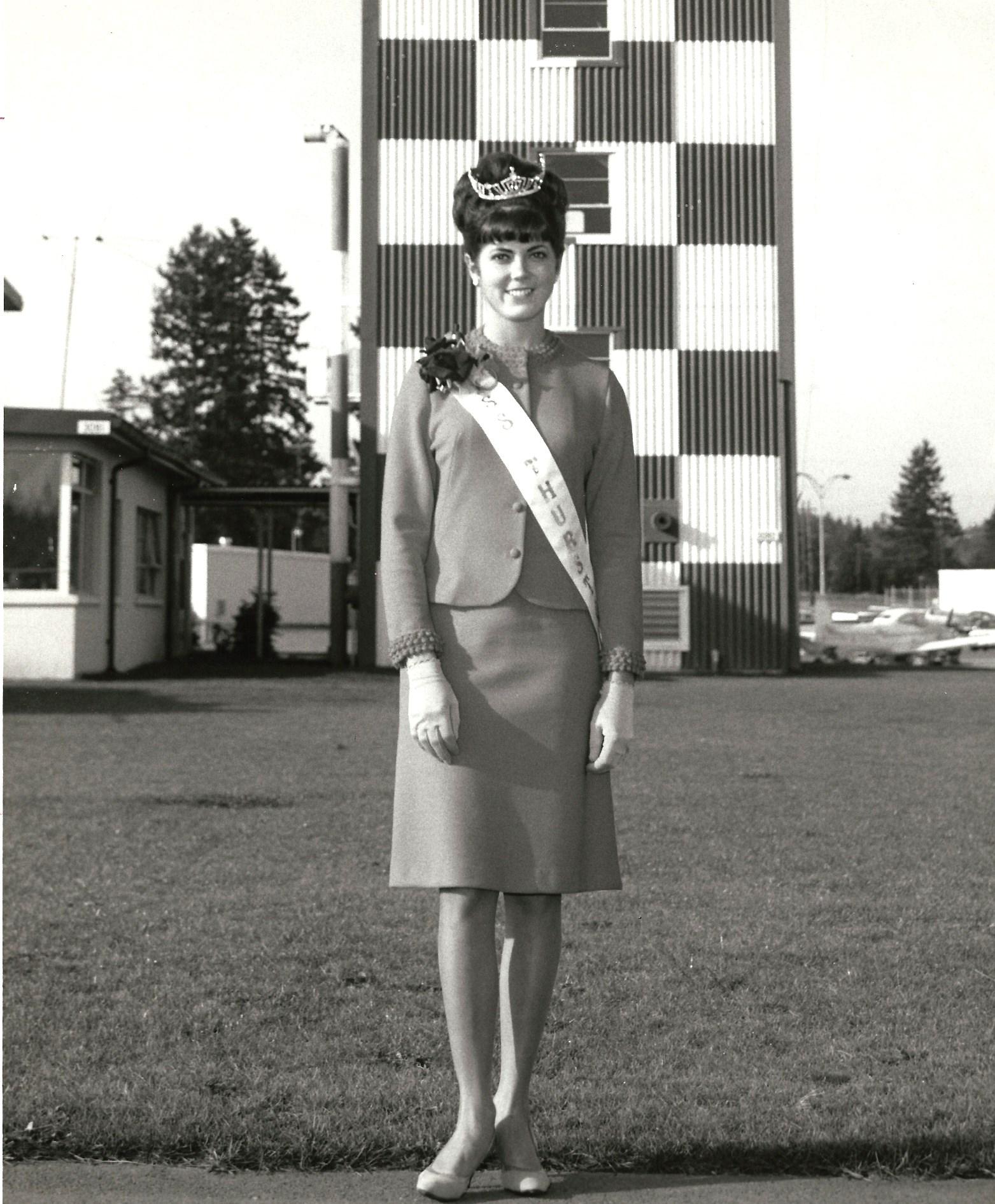
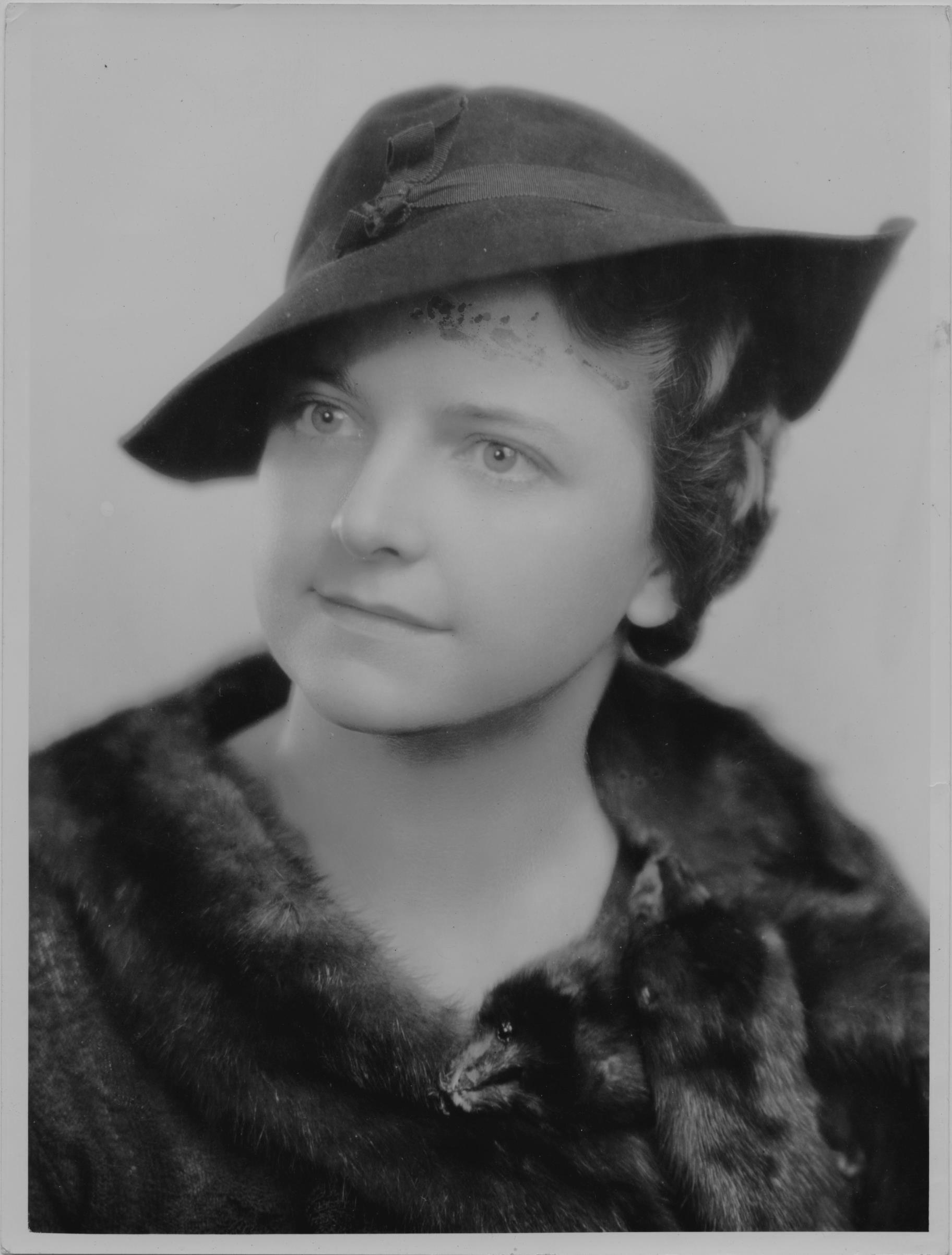



The Thurston County Historical Journal is dedicated to recording and celebrating the history of Thurston County. The Journal is published by the Olympia Tumwater Foundation as a joint enterprise with the following entities: City of Lacey, City of Olympia, City of Tumwater, Confederated Tribes of the Chehalis Reservation, Daughters of the American Revolution, Daughters of the Pioneers of Washington/Olympia Chapter, Lacey Historical Society, Old Brewhouse Foundation, Olympia Historical Society and Bigelow House Museum, South Sound Maritime Heritage Association, Thurston County, Tumwater Historical Association, Yelm Prairie Historical Society, and individual donors.
Publisher
Olympia Tumwater Foundation
John Freedman, Executive Director
Lee Wojnar, President, Board of Trustees
110 Deschutes Parkway SW
P.O. Box 4098 Tumwater, Washington 98501
Editor Karen L. Johnson 360-890-2299
Karen@olytumfoundation.org
Editorial Committee
Drew W. Crooks James S. Hannum
Janine Gates Erin Quinn Valcho
The Journal does not offer a subscription service. To get your own copy, join one of the heritage groups listed at the top of this page. These groups donate to the publication of the Journal, and thus receive copies to pass on to their members.
Issues are also available for purchase at the Bigelow House Museum, Crosby House Museum, and Lacey Museum.
The Journal welcomes factual articles dealing with any aspect of Thurston County history. Please contact the editor before submitting an article to determine its suitability for publication. Articles on previously unexplored topics, new interpretations of well-known topics, and personal recollections are preferred. Articles may range in length from 100 words to 10,000 words, and should include source notes and suggested illustrations. Submitted articles will be reviewed by the editorial committee and, if chosen for publication, will be fact-checked and may be edited for length and content. The Journal regrets that authors cannot be monetarily compensated, but they will gain the gratitude of readers and the historical community for their contributions to and appreciation of local history.
Opinions expressed by contributors are not necessarily those of the Olympia Tumwater Foundation
Written permission is required to reproduce any part of this publication.
Copyright © 2018 by the Olympia Tumwater Foundation. All rights reserved.
ISSN 2474-8048
Number 6
August 2018

2 Helen Shank, Children’s Advocate
Karen L. Johnson
45 Live Through This: From Priory to Punk Rock
Megan Ockerman
Back Cover Who/What/Where Is It?
On the cover: Helen Sturtevant Cooper Swift Shank as a young woman. Photo courtesy of the Olympia Tumwater Foundation: Helen Shank Collection, 2016.8. See article on page 2.
Just east of the Olympia Regional Airport sits a group of abandoned barns, once known as the Trails End Stables. The buildings show all the signs of long neglect—faded paint, notrespassing signs, cracked pavement, and rusted gates. The complex is an island of forgotten history in a sea of close-packed housing developments. But just a few decades ago, this facility hummed with life: the neighing and snorting of horses, clip-clop of hooves, shouts of young competitors, applause of audiences and proud parents.1
The dream of Trails End Ranch, a regional summer camp, and Trails End Stables, an equine center, was brought to life by a remarkable woman who spent her entire career as a trailblazing advocate for children’s rights and needs: Helen Sturtevant Cooper Swift Shank.
Helen Shank achieved many milestones in her life of 86 years. She supervised the newly-created Washington State division of child welfare, served as superintendent of Maple Lane Girls’ School, established a children’s summer camp in Mason County and a second camp in Thurston County, served as the first female member of the Washington State parole board, was married twice, taught high school and university classes,
Helen Sturtevant Cooper, undated photo, but probably circa 1922. All images in this article, unless otherwise noted, are courtesy of the Olympia Tumwater Foundation: Helen Shank Collection, 2016.8.
and campaigned tirelessly for children. Personally, she was a strong-willed woman with a good sense of humor,

who acquired many steadfast friends. Those who grew up in her presence still view her as one of the primary female figures in their lives.
Helen’s grandparents came from the eastern United States. Both born in Pennsylvania, William H. and Mirrett2 Sturtevant married and lived in Sharpsville, Pennsylvania, where a daughter, Blanche Edith, was born in 1875.3 In 1896, Blanche married James Fennimore Cooper (presumably named after the famous author),4 and
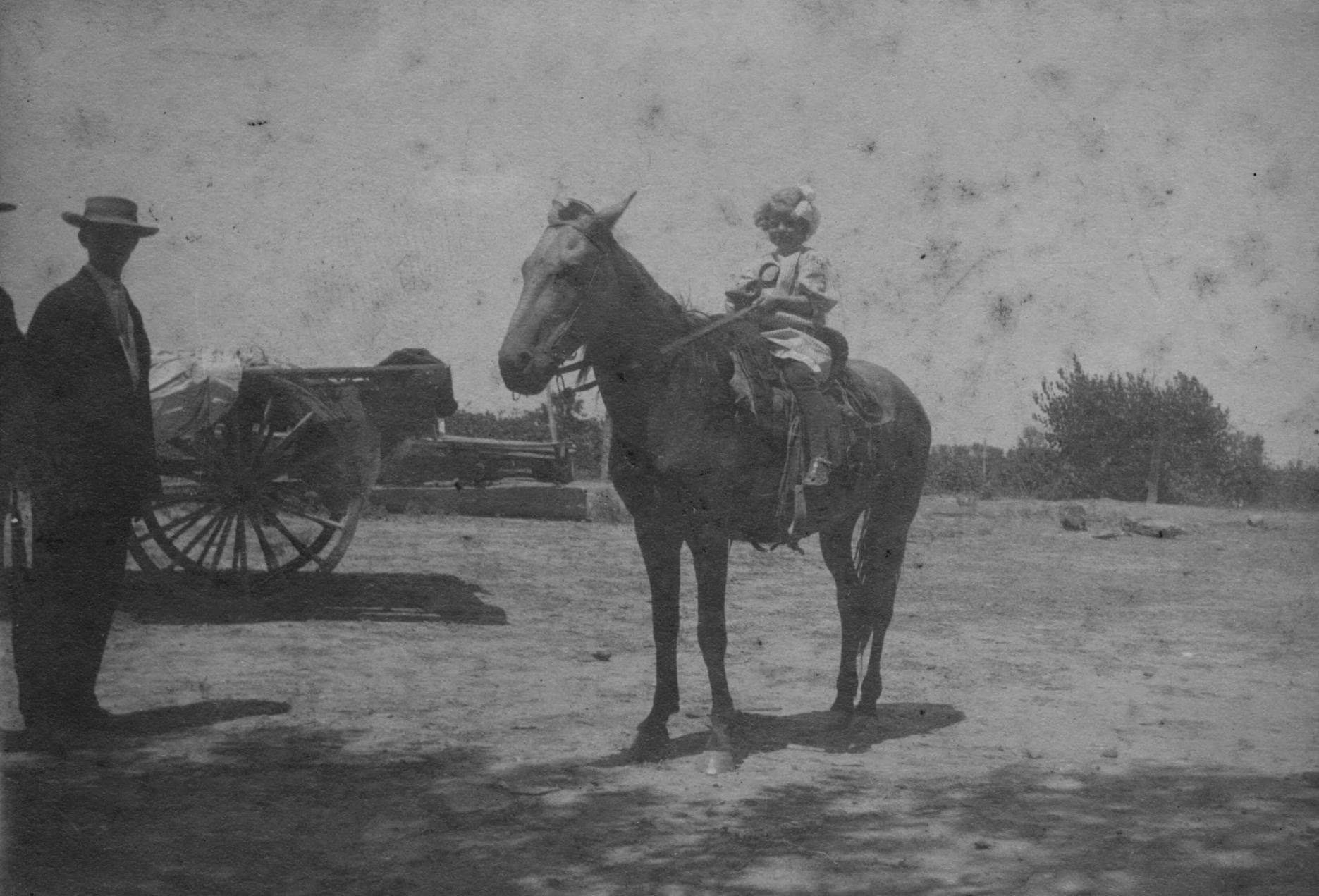
the young couple moved to Denver, Colorado, where they both taught in public schools.5 For a time, James served as president of a school known as the Cooper Commercial College.6 They had one child, Helen Sturtevant Cooper, born on November 28, 1900.7
Sometime after 1906, the Cooper family moved to Spokane, where James taught at local schools, eventually becoming head of the commercial department at North Central High School. James had suffered from chronic kidney failure for several years, and in early 1910 succumbed
to the disease.8 One must wonder if the loss of her father informed Helen’s decision to pursue social work as a career, and especially to focus on troubled children. Losing her father certainly would have given Helen the
empathy necessary to relate to children struggling to overcome difficult circumstances.
Sometime after James’s death, Blanche and Helen moved to the Bremerton area; why and precisely when is still a mystery. Perhaps Blanche was offered a teaching position; perhaps the move occurred for another reason.
Helen spent part of her pre-high and high school years at the Holy Names Academy in Seattle. Although formal transcripts of her time there could not be located, her name is listed in two school theatrical productions, and also appears in school registries for 1913 through 1916. Helen was listed as a boarder, so her mother quite possibly lived in Bremerton or Charleston (a Bremerton suburb) at the time, while Helen boarded in Seattle during the school year.9

Blanche remarried in 1917. Her new husband, and Helen’s new stepfather, was William D. Stineman of Bremerton. Stineman was in the real estate and insurance business until 1926, when he entered the safety-depositvault business and later joined the Western Gas Company. Blanche taught commercial subjects at Bremerton High School for years.10
After spending much of her high school years at Holy Names Academy, Helen graduated from Union High School in Bremerton in 1918.11
In the fall of 1918, Helen entered the University of Washington where she majored in education and minored in accounting. She joined the Mu chapter of Sigma Kappa Sorority in April 1919.12
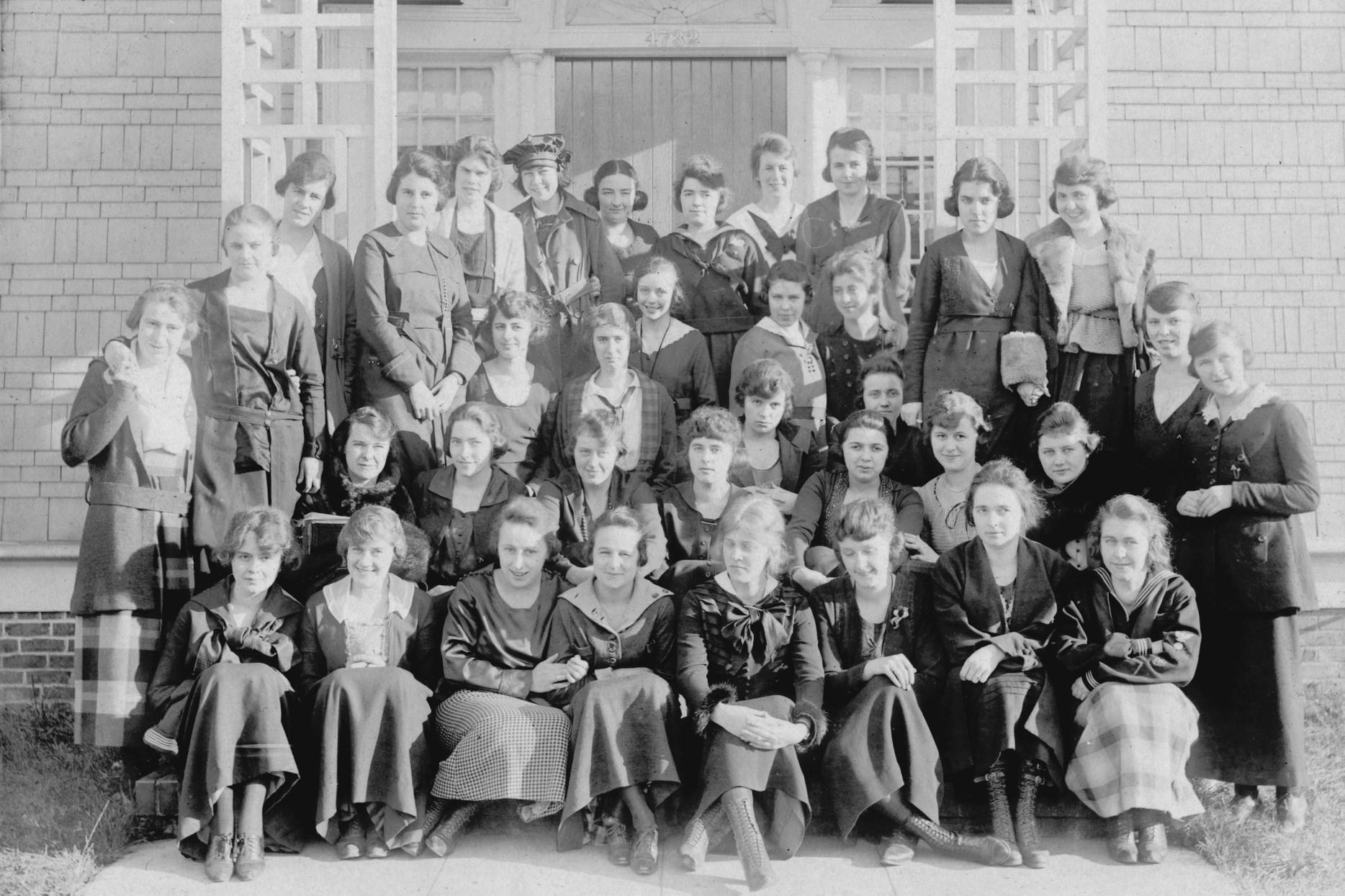
On June 19, 1922, Helen received a Bachelor of Education degree from the University of Washington.13 On the same day, she received her five-year normal diploma, which entitled her to teach in high schools or to supervise or superintend public schools in the state of Washington for the next five years.14
In the fall of 1922, Helen secured a job teaching English and commercial subjects at Olympia High School.15 This job lasted for two years, according to some sources. The 1923-24 Polk City directory for Olympia lists Helen as a teacher at the high school, and residing at 115 E. 20th . 16 But the Polk City directory for Kitsap County for the same year lists Helen as a teacher in Charleston.17 At the time, she was listed as residing with her parents on Wycoff Street in Charleston.
On June 11, 1924, Helen married Edward Alonzo Swift, Jr.18 Helen and Swift probably met at the University of Washington (UW). Swift sought a law degree there, where he was also a member of the Phi Kappa Psi fraternity.19 He enlisted in the Coast Artillery and saw active service in France during World War I, then returned to UW and completed his law degree.20 At their wedding, held at the Sigma Kappa sorority house near the UW campus, Helen wore “a powder-blue beaded georgette gown and carried a shower bouquet.” Reverend Ezra P. Giboney of Seattle’s Lawton Presbyterian Church presided. The bridal couple honeymooned in Seaside, Oregon, and then returned to set up housekeeping at the Weir Apartments in Seattle.21
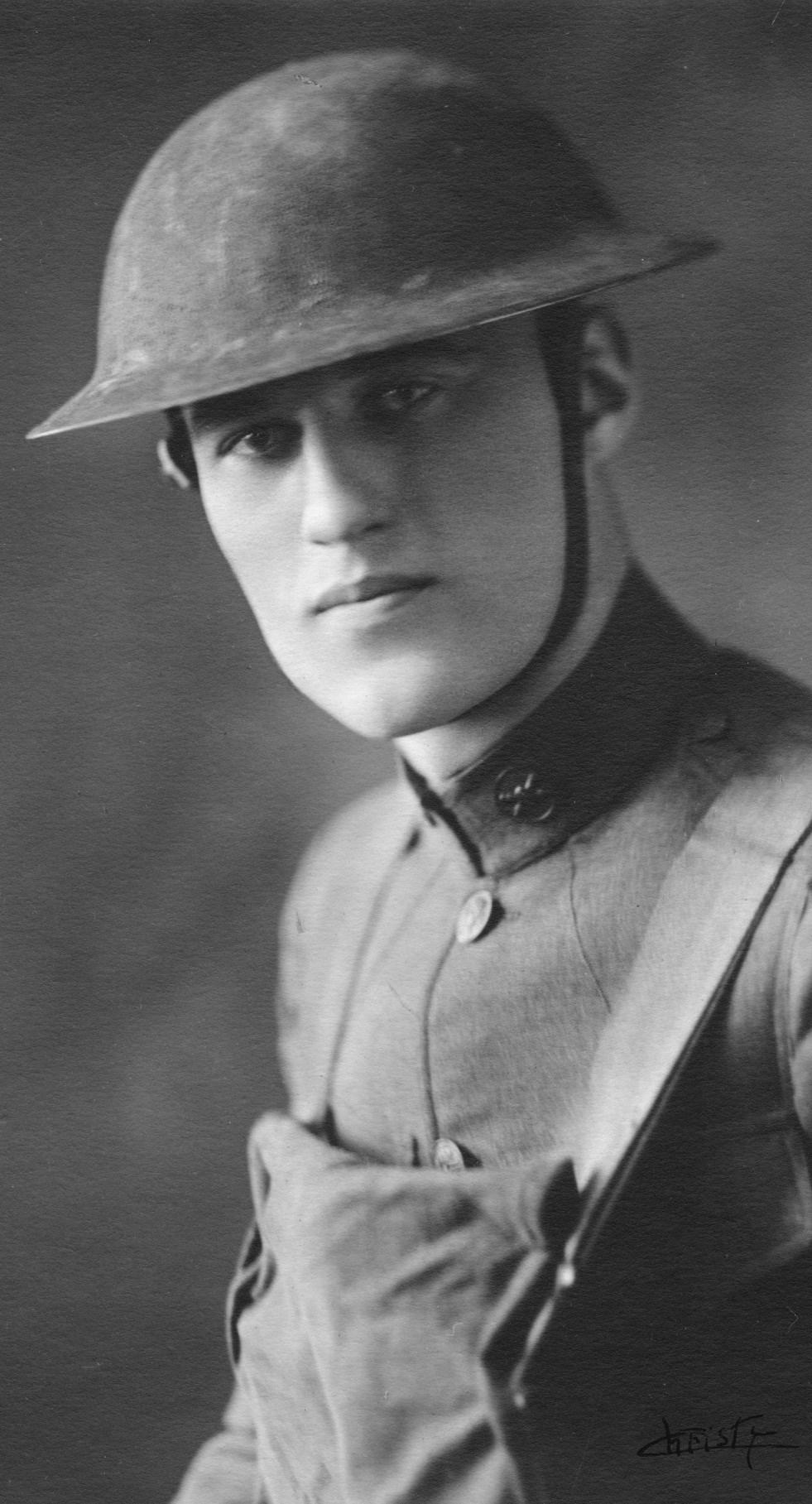
In 1926 Helen received a life diploma from UW.22 To be eligible for this diploma, holders of five-year diplomas were required to teach satisfactorily for at least two years in common schools. Helen’s time teaching at Olympia High School satisfied this requirement. Her life diploma entitled Helen to teach in high schools or supervise or superintend public schools for the period of her natural life.
During the 1926-27 and 1927-28 school years, Helen was employed as an assistant professor in Business Administration at the University of Washington.24 She also served as a member of the University branch of the American Legion Auxiliary. In
1928, she was appointed as president of Washington’s first district of the auxiliary.25
In 1926, Helen (second from right) served as a registrar and co-organizer of a typing tournament held at the armory at the University of Washington. Fifty high schools from the state qualified 175 students who vied for awards based on speed and accuracy. The grand prize was a trip to New York sponsored by the Underwood Typewriter Company.
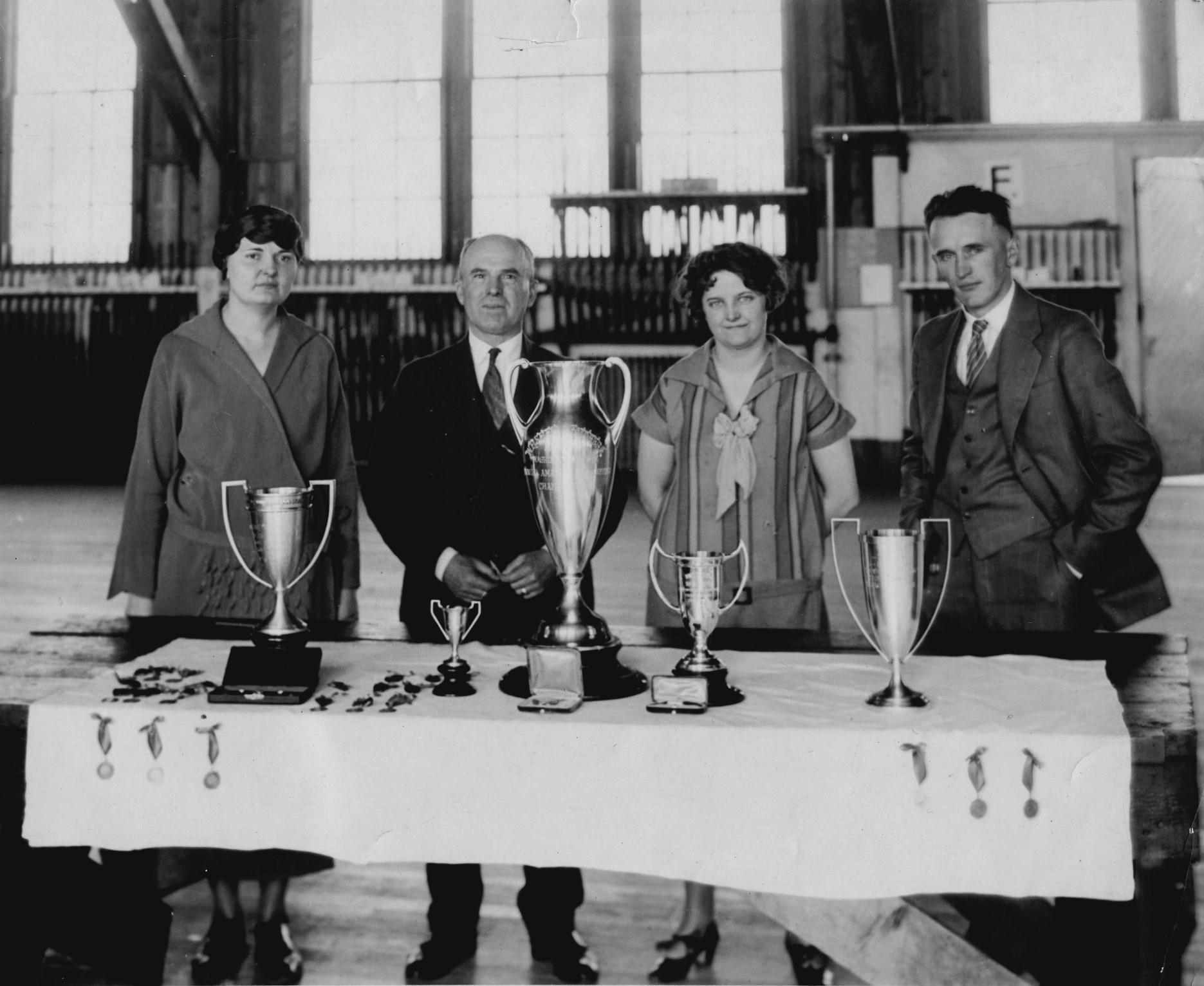
In 1929, Helen was named to lead the child welfare department of the American Legion Auxiliary, Department of Washington. The appointment was considered the most important one in the state auxiliary.26 The American Le-
gion had long been selling poppies (based on the poppy fields which marked where so many World War I soldiers died) to raise money for their charitable endeavors. Proceeds from poppy sales went: “to help save the home which X, ill now for many months, was trying to buy when he
was hospitalized; to buy shoes for the four rapidly growing, ambitious youngsters of Y, shell-shocked veteran, whose part-time employment cannot keep up with his expenses; to keep the baby of Z, blind victim of the war, supplied with milk and codliver oil Z himself pays the other bills, but the baby needs those two items; to pay the rent for A while he takes two month treatment, away from his job; to eke out the humble layette of B’s wife; to buy glasses to save the eyes of Tommy, oldest son of a World War widow.”27 As executive chair of the joint child welfare activities of the American Legion, the American Legion Auxiliary, and the Forty-and-eight, an American Legion offshoot,28 Helen’s job was to ensure that the child welfare division’s mandates were carried out.
One story typifies the work Helen performed for the American Legion child welfare committee. A war veteran, Lynn C. Worthington, had married a woman named Lola Hedge. After fathering two children, Worthington died in 1929,29 “and the mother disappeared after leaving the youngsters with her parents.” The Legion traced the widow to Hong Kong; Helen petitioned the courts to grant custody of the children to their maternal grandmother in Spokane. The court agreed. At the time, the children received $17.50 each per month from the government.30
injured when their car collided with a vehicle driven by an Olympia attorney near Lacey. Both women required hospitalization.31 Three months later, Helen and her husband sued the Olympia attorney for damages; the Swifts claimed that the attorney negligently drove onto an arterial highway (the old Pacific Highway) without stopping while driving at an excessive 60 miles an hour. Helen’s injuries included “knee damage, body bruises and cuts about the head.”32
Sometime between 1932 and 1934, Helen and Swift divorced for unknown reasons. Swift (nicknamed “Speed”) wasted little time in remarrying, wedding Marguerite Henigman in 1934. Marguerite died in 1949, and Swift again speedily remarried, having been a widower for less than three weeks. He died in 1952.33 In later years, Helen seldom discussed her first husband, but referred to him as “good old Speed.”34
In September 1932, Helen attended a Legion convention in Portland. On the way home from the convention, Helen and another Auxiliary member were
In 1935, Helen took a cross-country road trip to a child welfare conference in Phoenix, Arizona. The trip included a visit to her 84-year-old grandmother, Mirrett Hansen, who lived in Pueblo, Colorado. When she heard that Helen intended to pay her a visit, Mirrett bought Helen a new automobile as a gift and then decided to accompany her on the trip. The two logged about 400 miles a day, and visited not only Phoenix, but also Mexico, before returning to Seattle. Mirrett claimed that the much younger Helen was “plain tuckered out” at the end of a long day on the road.35
Meanwhile, the American Legion’s child welfare activities were so wellreceived and worthwhile that the State of Washington created its own official version. With a starting budget of only $1,500, a new children’s welfare division was established within the Department of Business, Budget, and Finance.
Helen was appointed as the first supervisor of the new state Division of Child Welfare. She assumed her duties on September 1, 1935 (at the salary of $200 per month, over $3,600 in today’s money).36 The new division’s mandates included “administering of relief to dependent children in their own homes, under the provisions of the federal social security bill signed recently by President Roosevelt and the state act. The other functions will be the supervision and certification of private agencies and institutions now providing relief for dependent children, duties formerly performed by the child welfare division of the old department of business control.” Before accepting the job, Helen resigned her position with the state’s American Legion Child Welfare committee.37
In 1938, Helen received a very special
invitation to meet First Lady Eleanor Roosevelt at the White House.38 Helen likely received this invitation based on her position as director of the state’s Division of Child Welfare. Whether for this trip to Washington, DC, or another, Helen’s mother Blanche had a travel trailer built for Helen. Apparently erring on the side of self-sufficiency, Blanche included a chicken coop on the side of the trailer, and even designed a drop-down ramp should Helen need to bring a cow or goat inside.39 It is not known if Helen took any livestock with her on her trip to the White House.
Helen went on to earn a master’s degree in social work at the University of Chicago sometime before 1940. No record of Helen living in Chicago dur-
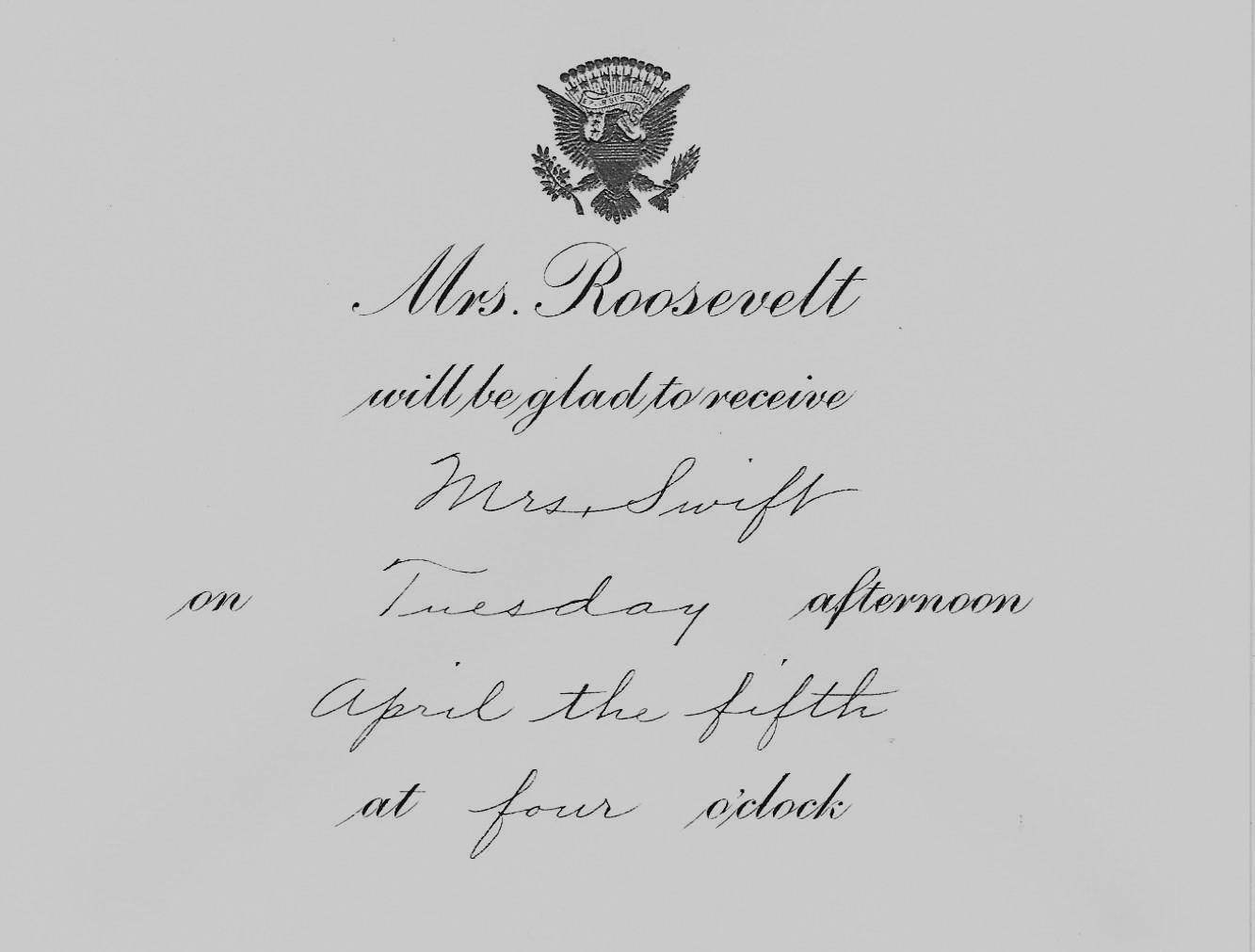
ing that time has been found, so she probably obtained her degree through correspondence courses at the university’s School of Social Service Administration.
In March 1940, Helen married Jack O’Rourke Shank.40 According to a family friend,41 Jack and Helen knew each other while both were students at UW. Helen’s sorority interacted with Jack’s fraternity. Whether Jack and Helen kept in touch over the intervening years, or whether they reconnected after her divorce from Swift, is unknown.
Jack was born in Colorado, spent part of his early life in Illinois, and eventually received a degree in forestry from UW. After graduation, he entered the rubber research field in Sumatra with the U.S. Rubber Company, and in South America with the Ford Motor Company. He had also served as educational advisor to the Civilian Conservation Corps camp in Leavenworth, Washington.42
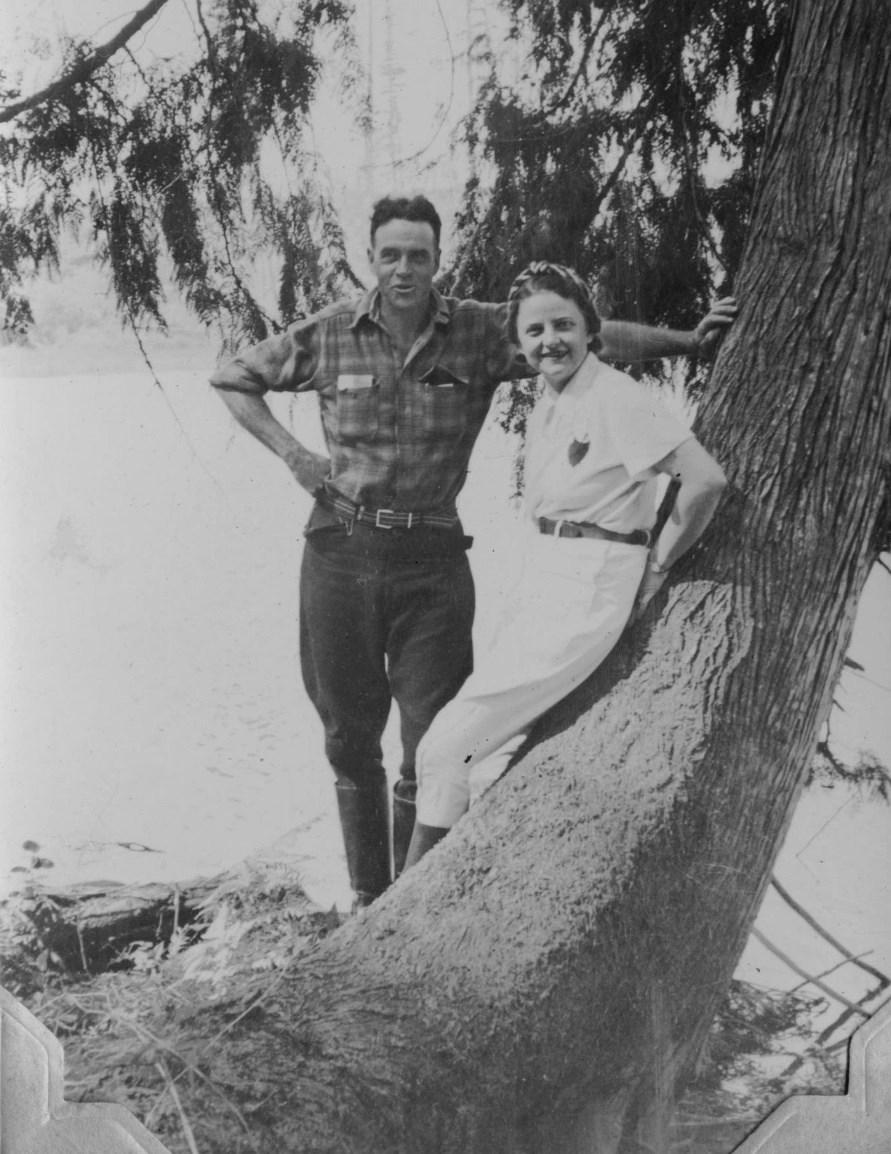
Directly after her wedding, Helen retired as supervisor of the Children’s Bureau, and went to live with Jack on a large tract of forested land, about 2,000 acres, in Mason County. Much of the land was owned by Jack’s father, Joseph F. Shank, who lived in Denver, Colorado; Jack managed the land in his father’s stead. Before Helen and Jack married, they signed a prenuptial agreement which stated that Joseph’s land would not become the couple’s community property, but would remain in Joseph’s name.43
When World War II was imminent, Jack joined the Army. He graduated as a first lieutenant from the sixth class of the Pacific Coast Transportation Corps Officers’ Candidate School at Camp Stoneman, California.44 He eventually was promoted to captain in the Transportation Corps, and was then stationed at Fort Lawton in Seattle.
Jack thought he would be far away from home for the duration of the war, so to keep herself busy, and to serve children, Helen decided to start a children’s camp on the lush land that she
and Jack occupied.45 The camp was named Trail’s End Ranch,46 and this and a subsequent ranch in Tumwater were to be the focus of Helen’s life for several decades.
The Trail’s End Ranch brochure described the camp as containing 1,800 acres on the Olympic Peninsula. Trail’s End Lake (formerly known as Prickett Lake) was the centerpiece of the property, which also had access to Hood Canal. Two other lakes on the property, Coon and Devereaux, provided fishing spots and sheltered waters for swimming and boating. Salt-water swimming and clam bakes were available on the Hood Canal private beach. Horse riding and care were highlighted activities. Apparently, Helen had a great love of horses, although she rode little in her adult years; she instead fostered the love of horses and riding in her young campers. Helen also had a fondness for dogs and cats, and usually had several in residence.
A typical ad for Trail’s End Ranch in Mason County. From the July 29, 1945 issue of the Daily Olympian.
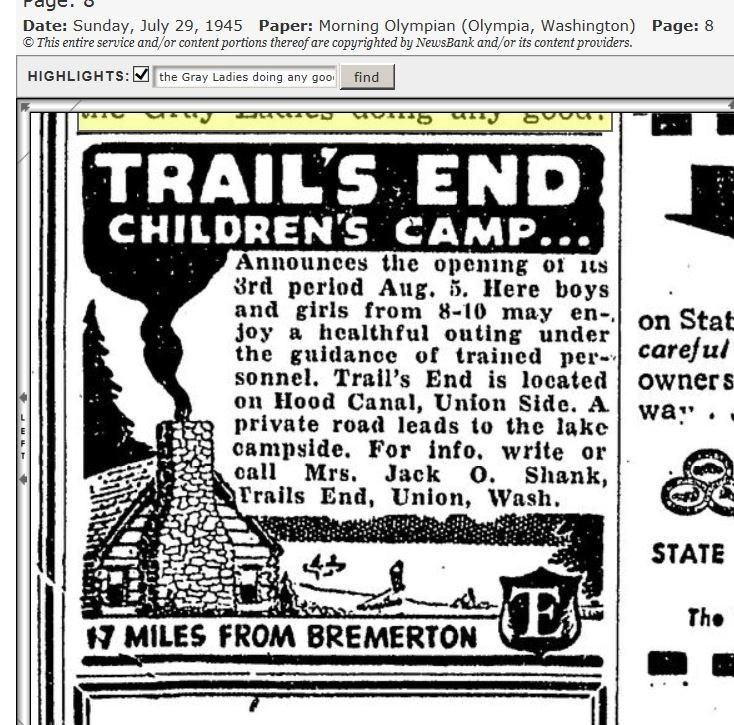
Every effort is made to help children develop desirable qualities of independence and self-reliance and to live with a group. Children return to their homes and face the new school year refreshed and invigorated after their weeks at camp.”47
The camp provided log and shake cabins for campers; each cabin housed six to eight children and a counselor. Campers were divided into age groups, and each group was named for one of the Washington Indian tribes. A camp brochure explained: “Except for the necessary routines, campers are given time to follow their own inclinations.
The eight-week camp season offered rates of $40 per week. Rates were dropped slightly for a five-week or longer stay, or when more than one child in a family attended.
Soon after Helen and Jack married, they informally “adopted” a teenage boy named Charles A. White.48 Charlie served in the Army in World War II,
then came back to Hood Canal where he worked at the ranch, primarily teaching campers how to ride and care for horses. After Jack’s death, Charlie moved with Helen to Tumwater and continued working at the new Trails End. Later in life, he discovered a talent for oil painting and was active in the South Sound Art Guild.49
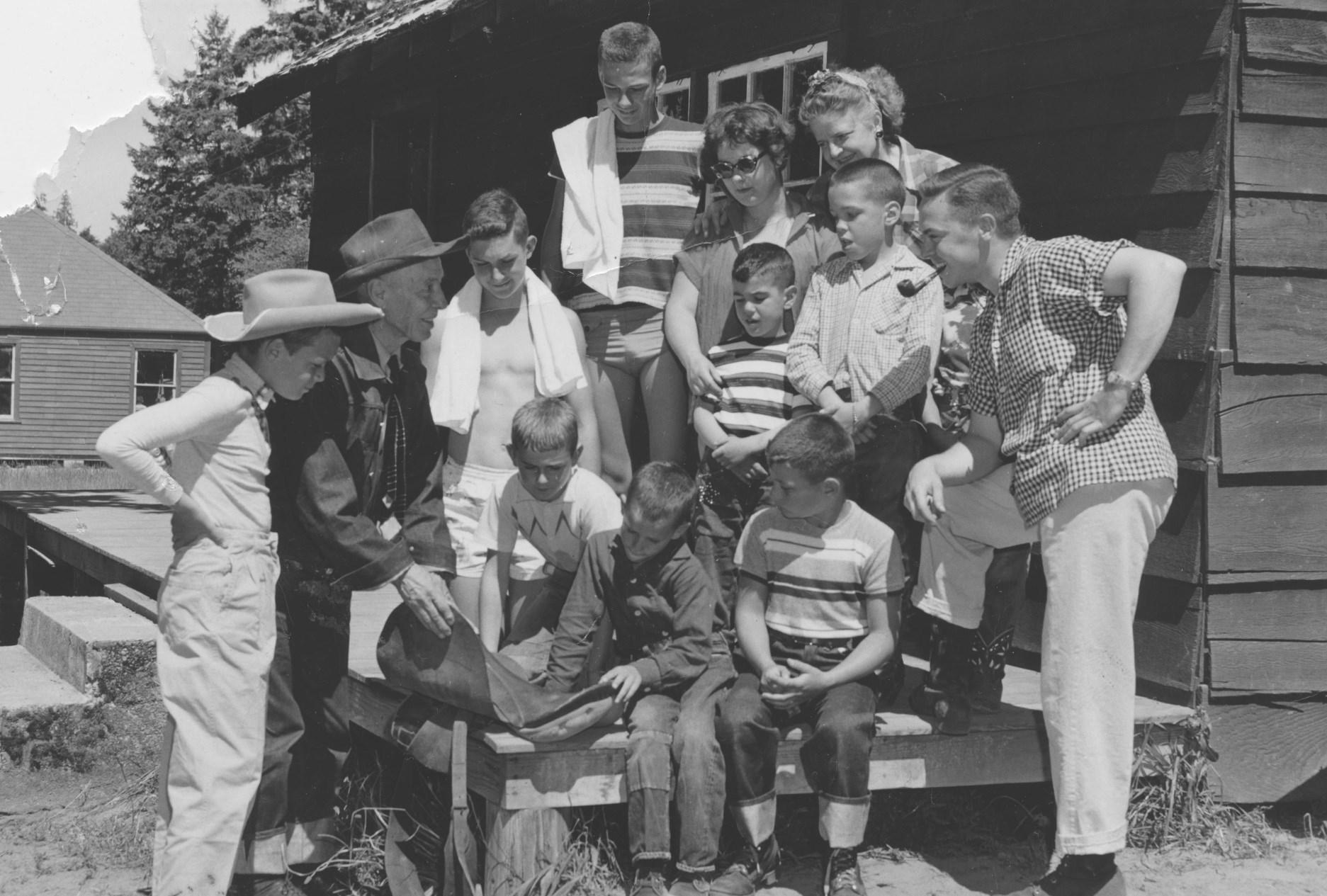
In 1943-44, Helen served as the executive secretary of the Children in Wartime Committee, part of the Washington State Defense Council.50
On the family front, in 1942, Helen’s
stepfather, William D. Stineman, died in Bremerton.51 The following year, her grandmother died in Colorado.52
Jack returned home from war duty, but must have been wounded during his service, as he was listed as a member of the Disabled American Veterans.53 He had only a few years of life left, for on February 27, 1950, he died in the U.S. Naval Hospital in Bremerton of pneumonia secondary to a brain tumor.54 He died without a will, and at least one source stated that the own-
ership of the Trail’s End ranch was left in doubt. In addition to Helen, Jack was survived by three sisters and one brother. Shortly after Jack’s death, Helen instituted legal action against Jack’s siblings; the intent was to foreclose against the siblings for any right, title, or interest in over 1,100 acres of Jack’s land (despite the couple’s prenuptial agreement). The outcome of the legal suit is unknown, but Jack’s sisters appeared on later maps as owners of Jack’s acreage, although they did not continue running the children’s camp. The land was later sold and developed into housing tracts. A family friend55 related that Helen indeed received a share of the proceeds from Jack’s land.
Helen must have owned some land in her own right, or she and Jack may have purchased some property during their marriage which then legally transferred to Helen’s ownership, because in 1953 she sold some undeveloped lots in Mason County. She may have also inherited land around Pueblo, Colorado, which she sold in later years, perhaps to finance her future purchase of Tumwater property.
Either in search of work after losing Jack’s land, or simply because she needed a change of scene, Helen moved to Thurston County. In 1950, she was appointed as superintendent of the State School for Girls at Grand Mound.56 The school, later called Maple Lane for the lines of maple trees gracing the entrance drive, was estab-
lished in 1913 as a juvenile rehabilitation facility. It originally housed 53 girls, but its population had grown to about 100 by the time Helen served there.57 Before her arrival, the school had gone through four superintendents in five years Helen hoped to bring some much-needed stability to the facility.
Helen offered a sobering description of the residents at Maple Lane: “The girls who are committed by the courts to Maple Lane School are delinquents because they have been rejected and deprived to the point of being mentally ill. Their backgrounds are varied but in almost every case there is a broken home, stepmother or father (two, three, or four), and poverty, although not in every case. And they have experienced such things as beatings, malnutrition, drunkenness, prostitution, and even incest. All of this adds up to an urge to seek attention in unorthodox ways by stealing, truancy, and sex delinquency. By the time they reach the school they have been so damaged that their faith in people has been destroyed.”58 Helen needed a strong will, a firm but generous attitude, and a compassionate nature to deal with these troubled children.
One of Helen’s first acts was to review the facility’s budget. She found a line item allocated for the installation of a tall chain-link fence around the entire perimeter. Sensing that the girls would feel even more marginalized and institutionalized behind a fence, Helen instead used the funds to hire additional and better-trained staff.59
In preparation for her role as superintendent, Helen “studied practices at the California state school for girls.”60 Bringing a new attitude to Maple Lane, Helen “stressed that the aim of the school is rehabilitation, not punishment, and that past history has taught that punishment has little effect in preventing future delinquencies.” Her new plans included: allowing girls to wear their own clothing and jewelry; bringing in professionals in fields such as hairdressing, modelling or nursing to give talks; and collecting magazines and other reading material for the girls.61 These changes were designed to “build self-confidence and pride and provide an additional incentive to conduct themselves in a worthy manner upon release.”
Despite these kinder-and-gentler innovations, Helen had to deal with many difficult situations during her superintendence. One of the first occurred only weeks after her appointment. In 1950, 21 girls from the school escaped following a post-Christmas party. Eleven of the girls voluntarily returned or were quickly picked up by Lewis County law enforcement personnel. The remainder of the girls were brought back later by sheriff’s deputies. Helen said, “The girls get homesick and blue during this time of the year. Just the other night several came back after a little walk. The girls were rather tense because many of them didn’t get any Christmas presents or hadn’t heard from their parents. You must remember that they are just adolescent youngsters, high strung, adventure-loving.”62
By 1953, Helen must have been looking for greener pastures, or perhaps a prospective employer was courting her. At any rate, Helen received correspondence and a job application from the Los Guilucos School for Girls in Santa Rosa, California. The State of California Youth Authority sent Helen an informative letter describing the school and stating that they were “glad to know that you are interested in giving consideration to a superintendency. . .”63 For unknown reasons, Helen did not accept the position.
Another of Helen’s innovations at Maple Lane was a theatre program. “In the fall of 1953 Mrs. Shank requested that the University of Washington send a teacher to train the staff and the cottage parents in creative dramatics. [Most of the girls lived in small cottages, which were overseen by resident staff or “parents.”] Agnes Haaga journeyed ninety miles each week from the university to conduct an extension course.”64 After several years of running the dramatics program, the staff was cautiously optimistic about the program’s therapeutic value, feeling “that creative dramatics is almost a necessity for children in institutions,” allowing them to picture a better life.
Helen often gave presentations to community groups such as the American Association of University Women and the Thurston County Mental Health Association. She focused on the definition of a delinquent, and how proper facilities and proactive programs could rehabilitate the girls. A newspaper ar-
ticle described her as “not only a social worker by profession but a progressive administrator who[se] program for rehabilitating girls is attracting national attention.”65
Still, escapes continued to occur over the years. More serious were attacks by the girls on fellow inmates or staff. In 1957, six girls attacked a cottage mother, Pearl Ryan, who required 50 stitches to close numerous cuts. One
of the girls was arrested on an assault charge. The intent of the attack was to take Mrs. Ryan’s keys and then effect an escape. Helen had to make some difficult but quick decisions in the aftermath of this attack. “Four of the girls involved in the attack were taken to Western State mental hospital at Steilacoom for observation. Two others were sent back to the county courts from whence they came for further disposition of their cases.”66

A year later, another attack occurred inadvertently during a melee in one of the cottages. Six 15-year-old girls rebelled against an 8:30 bedtime and became abusive when Helen arrived at their cottage to enforce the rule. The girls “began wrestling among themselves. In the process, they knocked out several panes in a French door. Mrs. Shank sent for brooms and told the girls to clean up the television room where the trouble occurred. Instead, they broke the broomsticks and in swinging them around caught [a staff member] in the eye. Three state patrolmen and two Lewis County deputies, summoned by the superintendent, quickly herded the recalcitrant girls into makeshift security quarters in the basement of the cottage, ending the incident.”67
During her time at Maple Lane, Helen inspired the development of Birch Cottage, a special “rehabilitation program within a rehabilitation program, one of the first of its kind in the United States.”68 The intensive program focused on truly hard-core delinquents who could not adjust to life in the regular Maple Lane atmosphere. In 1967, Gordon Newell (local author and then director of information for the State Department of Institutions) wrote an article about Birch Cottage. Newell’s story was published in Reader’s Digest, and brought national attention to the innovative facility. By the time the article was written, about 95 percent of the “graduates” from Birch Cottage had found their place in society, but the administration cautioned that further research on recidivism was need-
ed before the program could be considered successful.
By 1959, newspapers reported on pay raises for many officials at various state institutions. Helen’s annual salary increased from $8,748 to $12,45669 (a jump from $73,638 to $104,850 in today’s dollars).
That same year, Helen came closer to realizing a long-held dream: establishing a group home or halfway house for delinquent girls. In August 1959, Helen and several colleagues signed articles of incorporation for the Group Home for Maple Lane Girls, “a home where girls could live communally until they have enough confidence in themselves and in society to live alone.”70 Helen contended that the lack of such halfway houses was a weak spot in the rehabilitation program, thrusting young women with no family, friends, job or support system back into society to fend for themselves. The incorporators quickly recruited several Seattle-area business professionals for a board of directors and also began looking for a suitable house.
Several months later, the organization had segued into Group Homes of Washington, Inc., and a large home in Seattle was found. Many of the residents in the area, of course, were opposed to having parolee girls living in their neighborhood. Even the local Episcopal Diocese adopted a not-inmy-backyard attitude. A news article reported, “Mrs. Shank said such girls are screened carefully before being pa-
roled. She emphasized that they are girls with emotional problems caused by troubled backgrounds.”71
Despite lobbying efforts by the board, this first home choice never came to fruition. Instead, the group kept working for another three years, when enough money had been raised to purchase a home, and furnishings, on Seattle’s Capitol Hill. Finally, Helen’s dream became reality in the old refurbished house where sixteen young women at a time could be eased back into society. “To many, it will be the first real home they have ever had.”72
While Helen was busy establishing a successful career at Maple Lane, she was also re-creating her old Trail’s End ranch for children. Between 1951 and 1953, Helen purchased several adjoining parcels of land and cobbled together around 300 acres on Bush Prairie in Tumwater. This land was destined to become Trails End Ranch and Trails End Stables.
Apparently, when Helen bought the acreage around what would be named Trails End Lake (earlier known as Bush Lake and Drewry Lake), a single

cabin-like home existed on the north end of the lake. Workers constructed the camp during the winter of 1953 and spring of 1954, and the ranch opened for business in the summer of 1954. Helen also petitioned the county for the establishment of a road to access her property.73 Some equipment from the old Trails End camp in Mason County was brought to Tumwater. According to a family friend, “The lodge and the first two cabins were put in by a Gig Harbor company that built log cabins. After those were put in, Charlie White and a helper added a third cabin.”74
In the spring of 1955, Charlie White, Philip Meade, and others demolished a small dock that had existed on the south end of the lake, and built a larger dock. In the next few years, Helen saw an opportunity when some nearby houses were condemned in connection with the construction of Interstate 5; these houses were purchased and moved to the camp. The buildings served various functions: residences for campers, counselors and caretakers; infirmary; office space; and so on. Helen obviously planned her camp carefully and frugally, re-using structures when possible, and building new structures when necessary.
In 1955, a new organization was formed from the merger of seven social work organizations. The new entity was named the National Association of Social Workers, and Helen became a charter member.75 Today, the NASW is one of the largest membership organizations of professional social workers
in the world. That same year, Helen’s mother died. She was buried in a Bremerton cemetery.76
The ranch at Olympia, which operated for only about eight weeks each year, attracted campers from across the Northwest. Press releases written by Helen and her staff included mentions of campers from Seattle, Tacoma, Bellingham, Bremerton, and other areas.
Camp counselors (at least those of legal age) occasionally hid bottles of beer in the toilet tanks in staff cabins (the water in the tanks was clean and kept the beer cold). After lights-out for the children, the counselors would take the beer out to the lower pasture for a bit of conviviality. Helen must have known about these little outings, but never said anything, trusting the parties not to get out of hand.77
Helen’s home at Trails End featured many artifacts that her husband Jack had brought back from Sumatra and other lands he had visited during his days on rubber plantations. Native spears, arrows and carved wooden masks decorated the walls; antlers, deer hides, and a jaguar hide were also displayed. Some of the artifacts were exhibited in the camp’s lodge for the campers’ enjoyment.
After serving as Maple Lane superintendent for ten years, and accomplishing much during that time, Helen had planned to retire and focus her time on Trails End. However, a gubernatorial appointment soon added a new duty to her life.
In March 1960, the front page of the Seattle Daily Times proclaimed “Woman Is Appointed To State Parole Board.”78 Helen had just been named by Governor Albert Rosellini79 to complete the term of James Skaggs, who had resigned his position on the State Board of Prison Terms and Paroles.80 Helen was the first woman to serve on the Washington state board and one of
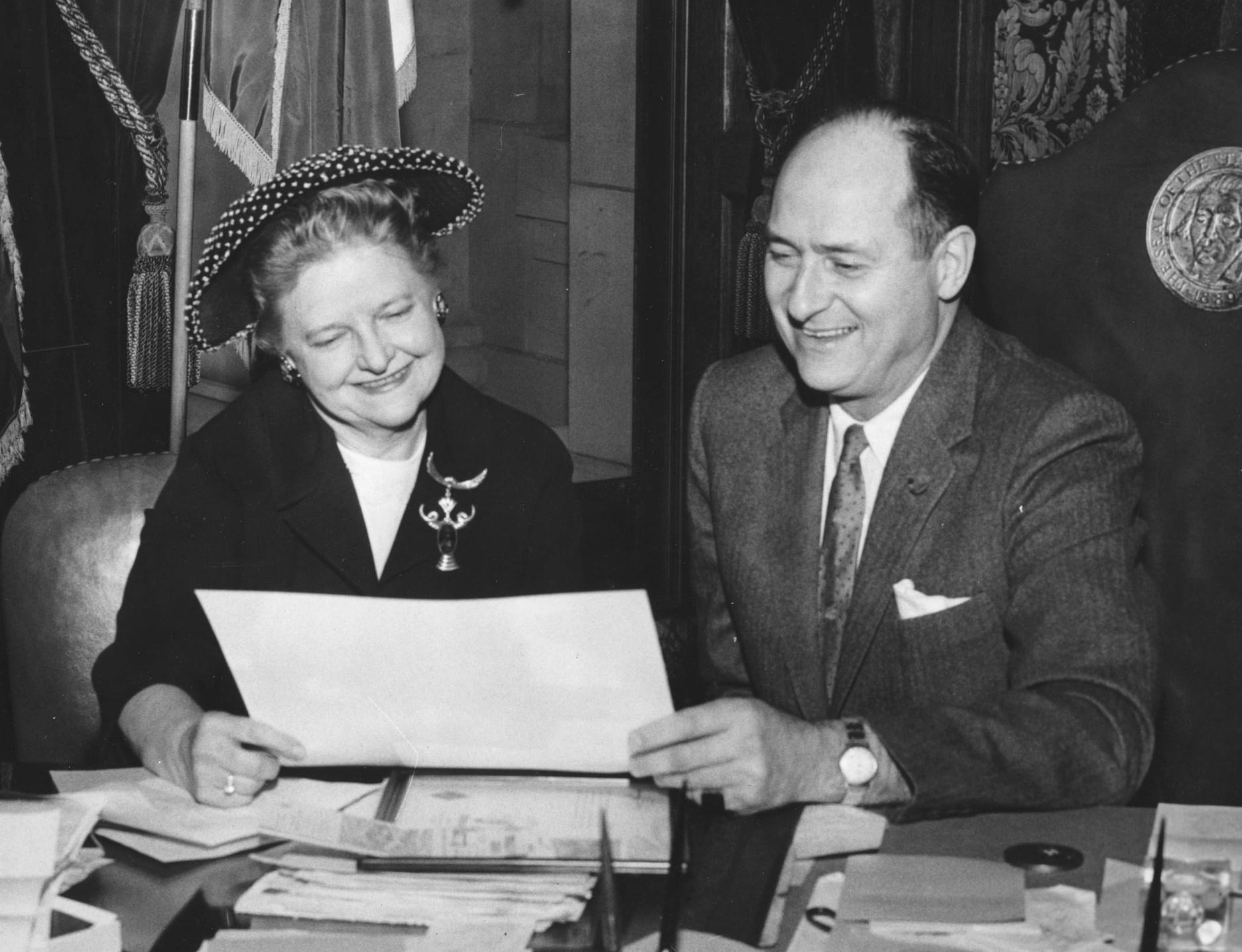
the very few women in the entire country to serve in such a position.
The Times article quoted Helen’s reasons for agreeing to the appointment: “I had been saying I was going to put my feet up and retire next year. But this position appeals to me. I am vitally interested in the parole program.”
The Parole Board chair, Harris Hunter, stated, “Because of her back-
ground in this field and the fact she is a woman, Mrs. Shank certainly will give the board new approaches to the very great problems in parole.”
Helen was required to resign from her post at Maple Lane, since having an additional occupation precluded serving on the parole board. However, the state attorney general reviewed her case and approved her continued operation of Trails End: “. . . her youthcamp activity was known to the state administration before her appointment to the board and her right to serve is supported by an attorney-general’s opinion.”81
Even so, Helen’s appointment did not meet with unanimous approval. Some months after the appointment was made, Senator Herbert Freise, Walla Walla, charged that Governor Rosellini “made the appointment last March with knowledge of what Freise said was Mrs. Shank’s ineligibility to serve.”82 State Representative Alfred Adams, secretary of the Legislative Council, also criticized Helen’s position on the board. Adams claimed she had a conflict of interest due to her continued operation of the Trails End camp. Adams also criticized other recent appointees to the board, saying “I do not believe we are getting people on that board who have the confidence of the public.” Nevertheless, the Legislature approved Helen’s appointment by majority vote.
One must wonder if politicians truly questioned Helen’s eligibility for the parole board, or if they were preju-
diced against any woman joining a previously males-only clique.
In late 1961, Helen was embroiled in another controversy, this time related to a difficult decision the parole board had made. The board was asked to rule on releasing convicted murderer John Gasser from the state penitentiary. According to a news article which contained a graphic description of the crime, “Gasser had been convicted in 1948 of the brutal slaying of 22-year-old Donna Woodcock, described as a young woman with a pretty smile . . . She had been sexually assaulted, gashed and mutilated with a broken beer bottle and strangled with a strip of cloth.”83 Gasser confessed to the killing, was convicted of first degree murder, and was imprisoned under a life sentence with no possibility of parole. In 1951, however, the laws regarding parole changed, setting “the minimum sentence for persons receiving life sentences at 20 years minus time off for good behavior.”84 A decade later, Gasser’s case was reviewed, and the consulting psychiatrist had few reservations about placing him back into society. While incarcerated, Gasser had “earned four post-graduate credits, completing a short-hand course and a two-year correspondence course in basic accounting.” He had also clerked in the inmates’ store and had been in charge of the curio store.
Helen was a parole board member when Gasser’s parole request arose. She and another board member, H. J.
Lawrence (a former Seattle police chief), “initially had interviewed Gasser and had studied reports from psychiatrists, psychologists and other clinicians before taking the matter to the full board.”85 Even though the original jury had recommended that Gasser never be paroled, Gasser had been a model prisoner, and the current laws
granted parole candidates one-third time off for good behavior. Having studied the case thoroughly, Helen and Lawrence, who both had extensive experience with the penal system, had no problem recommending that Gasser be paroled. The rest of the board concurred, and Gasser was released, to the shock and consternation of many citizens who had believed Gasser would be imprisoned for life.
Responding to public criticism of the decision, Helen and Lawrence wrote a letter to the editor of the Seattle Daily Times. 86 That letter outlined the reasons behind the board’s decision, including rehabilitation, good behavior, and the unlikelihood of Gasser’s committing another murder. The letter stated, “We feel this man is now ready to return to society. He was 20 years old when locked up, and will be almost 34 years old when released, and . . . longer time in prison will only make him more dependent on the institution. We feel that if this man is to make a readjustment into society, this is the time. . . . We feel we have a job to do, and, though sometimes it is controversial, we do the best we can with the facts that are before us.”
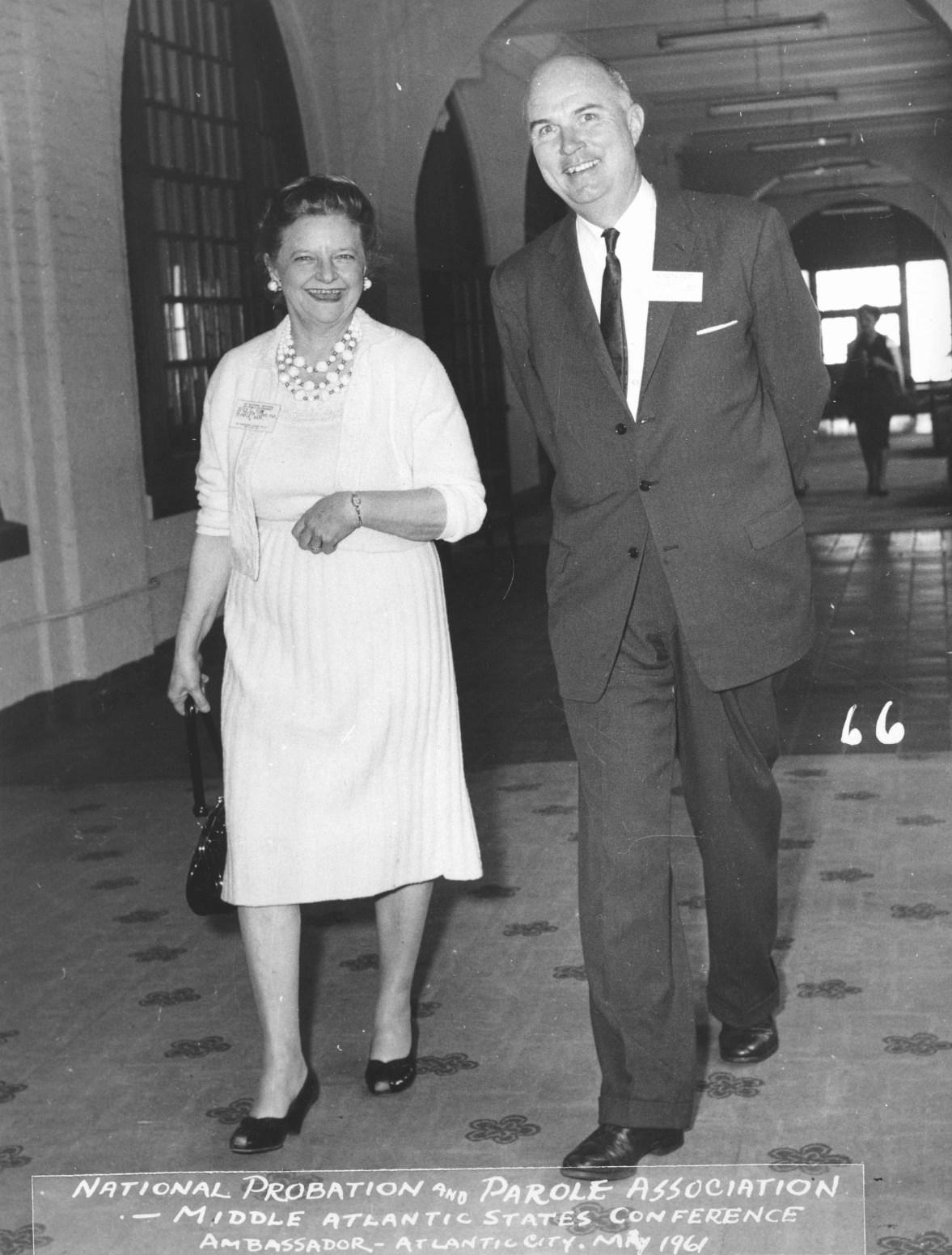
Despite the board’s due diligence, Helen’s vote to parole Gasser came back to haunt her, and western Washington, two decades later.87
In September 1962, Helen announced her retirement from the parole board. In a news article, she “said she had been advised to take a six-month rest. In her letter of resignation to Governor Rosellini, she said a mere absence from the board during that time ‘would be too much of an additional burden on the other members.’ ”88 So she decided to resign.
However, Helen’s continuing interest in the parole system is evidenced by the number of newspaper clippings she kept through the early 1960s, even after she stepped down from her appointment.
In 1963, the Parole Board came under fire again, and Helen weighed in with her opinions although she was no longer on the board. Up to this time, the appointment of parole board members had been largely politically motivated. Helen, and others, believed that “there should be high qualifications and examinations” rather than political appointments.89 She also felt that a Department of Corrections should be created in Washington State, following California’s example, and that this new department should include two divisions youth and adult “with good, strong county offices. The field staffs for both youth and adult services should be included. This would
provide continuity all the way through. Then the Parole Board could act strictly as a quasi-judicial body, holding parole hearings. That’s what it is supposed to be.” Various newspapers published many column-inches on the parole problem. The state finally established the Department of Corrections in 1981.
In 1963, Helen was elected the 196465 president of the Western Washington section of the American Camping Association.90 Trails End Ranch was a member of the ACA.
Helen publicized the Trails End Ranch in newspapers, campers’ association publications, and other venues. One of her 1963 press releases said, “The three hundred acre ranch, located at the end of the Oregon Trail, affords young campers an opportunity to enjoy horseback riding, swimming, water skiing, firearms training, overnight camping trips, and a three day pack trip on horseback into Washington’s Cascade Mountain Range.” Other activities included fishing, camp-outs, boating, archery, softball, volleyball, badminton, ping-pong, crafts, and evening campfires. Press releases also usually included a brief description of a particular camper being of interest to a specific newspaper; for example, “Pamela Haverlock, daughter of Mr. and Mrs. Bert Haverlock of Bellingham, is spending part of her summer vacation enjoying the unique camping facilities of Trails End Ranch near Olympia, Washington.”91
The ranch brochure also listed all personnel with Helen as director, and additional staff as assistant director, pack trip guide, riding instructor, and trail ride supervisor. Other staff included a waterfront director, activity director, registered nurse, pediatrician, cooks, adult counselors, and counselors-in-training. Camp rates ranged from $210 for a three-week stay to $535 for a full eight-week experience. Discounts were given for sib-
lings. “Come to Trails End Ranch for your next camping season. Live on a lake in the deep woods. Sleep in a rustic cabin under the maple trees, in warm, comfortable cabins. Eat wholesome food in the big log lodge. Ride and play in the 260 acres of forest land and rodeo bowl. Fish in the lake and Deschutes river.”92


“The camp had a lot of repeat campers each year, and people renewed friendships each year. There were a number of rituals and ceremonies that encouraged good behavior and rewarded accomplishments. The camp ran on a schedule that included signaling events by ringing a large metal bell. The camp had a strong swimming program. There were aluminum boats with oars, and a small water ski boat.
“Each summer there were a few square dances that were called by ‘The Judge,’ Justice Robert C. Finley.93 He visited the camp regularly and was an impressive, though quiet, man.
“The camp had access to trails for hiking and horseback riding. We were occasionally taken to the Deschutes River to camp, and some campers were allowed to float the river on inner tubes, after being deemed accomplished enough in water safety. It seems at least once a year a camper and a skunk came into contact, with a bath in tomato juice the subject of discussions that followed.
“The lake was full of life. Lily pads and lake plants, insects and larvae, fish. Skunk cabbage and cattails surrounded the lake. Dragonflies and frogs were abundant. Several different kinds of frogs, including bull frogs. There were alligator lizards on rockery nearby, and garter snakes all around. Lots of crickets and grasshoppers.
“The property had an old rodeo bowl. The Olympia Police Dept. and the Thurston County Sheriff used the
bowl for a rifle range, and had a shack there for some of their equipment. The bowl had remnants of the wood fencing and chutes used in the rodeo operation.”94
The ranch also offered what might be considered an unusual activity by today’s standards: firearms training. The ranch brochure stated, “Every young American wants to try his hand with the weapon which has had so much to do with the development of this country. As members of the National Rifle Association [supervise], each camper is taught safe handling of firearms which becomes an unbreakable habit. With a safe range, capable supervision and instruction by the men of the Olympia Police Reserve the campers learn to fire and enjoy the competition among themselves.”95
A 1964 news article also added outdoor survival, astronomy, compass reading, and forest fire control to the list of skills taught.96
In 1965, a new piece of old history was acquired for the ranch, and as usual, Helen turned it into a fun learning project for campers. Helen wanted to dress up the interior of one of the ranch buildings, and found a treasure which needed some loving care. Back in the early 1890s, a twenty-foot-long mahogany bar was carved on the East Coast and brought out to the Northwest, allegedly by sailing ship around Cape Horn. The ornate bar was destined for the Anchor Tavern on State Avenue in Olympia. Decades later, the tavern was razed and the bar was
stored away. Helen came across it in 1964 and purchased it for the ranch. “Sadly showing its age, the bar set slowly was restored to its former brilliance by young guests of the ranch and even their parents who were caught up in the spirit of the project. All would scrape away at the hard knocks of time until, after a year, the bar was ready for installation in the special log house built to receive it. Trail’s Enders call it their Trading Post.”97
Helen received a Camping Appreciation Award from the American Camping Association, probably in the mid1960s. The award she received describes her contribution: “Your interest and active participation in camping for the young people of your community deserves the thanks and praise of all residents, for the challenges of the outdoors help build the young people of today into the leaders of tomorrow.”98
In the mid-1960s, Helen began a new venture: an equestrian center. By some accounts, Helen was talked into establishing this business against the advice of her closest friends. However, she did love horses, had worked with them in the past, and obviously saw this as a way to put that experience to use in continuing to work with youngsters and adults alike.
Alton Lorang; and J. Arthur Blair, with an initial capital of $100,000. In 1968, the capital was increased to $250,000.99 Lorang, a Tenino cattleman, served for some years as an officer of the Thurston County Cattlemen’s Association.100
“Trails End Stables presented its grand opening with an open horse show Sept. 11-12, 1965. It became a popular site for shows of many breeds and, during the off season, housed antique shows, scout-a-ramas and cycle races.”101
Although the stables were meant for horses, Helen occasionally hosted visitors of other ilk. In 1967, a man on his way to Canada pulled up looking for a place to stay while his two pregnant goats cooled their heels until health certificates could be issued. The goats were accompanied by a mare, four game hens, and a dog. Helen cheerfully provided accommodations for the menagerie, although at first she thought the man was joking: “Only the day before, somebody called pretending to want a stall for an elephant.”102
Trails End Stables, Inc. was incorporated in March 1965, by Helen; attorney and personal friend, Phil Meade;
In 1968, Helen made a serious change to her Tumwater holdings and her life. She sold the Trails End Ranch, including 150 acres, fourteen log buildings, and Trails End Lake, to the Northwest Regional Jewish Synagogue for a reported $300,000. The facility was renamed Camp Solomon Schechter. The new owners planned improvements such as a large recreation building, four new living units, play fields, tennis courts, and ball fields. Helen re-
tained 150 acres as well as the horse arena, thus ending 25 years of work
Helen was very enthusiastic about other animals in addition to horses.
The large arena at Trails End Stables as it was being built in 1965. The building contained a 200’ by 90’ clear span arena with seating for about 2,000. With stalls, lobby, and waiting areas, the building measured 256’ by 190’ overall.

the old William Owen Bush home, not far from Trails End.105 Helen often visited the old house “and worried over its deterioration. Three years ago, as president of Soroptimist Club of Olympia, she suggested they try to interest the public in restoring the Bush home before it crumbled into splinters and dust.” Although the club members vigorously lobbied the legislature and the State Parks and Recreation Department for funding and support, the project never came to fruition, and the Bush home was demolished in 1970.106
The “Helen Shank Trail Days” of the 1970s honored Helen’s commitment to her ranch and stables. The 1974 gala was managed by Bob Gunter, ranch manager, and Morris Loveless, “an Olympia promoter who is putting together a land development plan for the ranch and contiguous property.”107 (Loveless was perhaps better known locally for having established Panorama City, a retirement community near Lacey, a decade before.)
Helen developed yet another interest in her senior years. Her long-time

friends Robert (Washington State Supreme Court Judge) and Werdna Finley were booked into a course of pottery lessons. Werdna turned out to have an allergy to some of the chemicals used in throwing clay, or perhaps just didn’t enjoy the craft. But Robert continued on and enticed Helen to try her hand at pottery work. Helen became so enamored of the craft that she converted an old milk shed on the Trails End property into a “pot shop.” There she and Robert shaped clay into vessels; Helen also made bits of clay into droll figures of people and animals.108 “Everyone should do something like this,” said Helen of her pottery. “Working in clay is soothing. When Bob comes to the shop from the Statehouse looking like a storm cloud, he tends to throw tall, heavy pieces. When he’s in a tranquil mood, he makes the curve wider and milder.”
Robert’s son Randy Finley felt that his mother Werdna was always a bit jealous of Robert’s relationship with Helen. Even though everything was strictly platonic, Robert was very fond of Helen and enjoyed spending time with her at Trails End.
Family friends remember that Helen had many male friends over the years, but did not know if Helen was intimate with any, or if she ever had a long relationship with any man after Jack’s death. They also remembered that Helen formed friendships with many ministers, and always had a daily prayer or benediction for campers, but she was private about her own religious beliefs, and seemed not
to be committed to a particular religious denomination.
In 1977, Helen sold a part-interest in Trails End Stables to Raymond “Eddie” Armstrong and his business partners, Barbo-Daniels & Company.109 Although Helen sold her remaining financial interest in the stables in 1978, she continued to advise the owners and involve herself in planning activities at the arena.
In 1979, another facility was added to the horse arena: the Trails End Restaurant. Opening in December of that year, the restaurant offered “the finest lunches and dinners” featuring hearty steak and seafood meals. “Enjoy the finest in dining pleasure while viewing horsemanship at its best. Or sit back in the Saloon and watch the show.” Free parking and live country music were also offered.110
Over the next few years, Eddie Armstrong and Helen tried many angles to promote and make full use of the stables: rodeos, wild cow milking events, sheriff’s posse involvement, 4-H meetings, a snack bar, various horse shows, antique shows, country music programs (including Merle Travis), and a photography studio.111 In 1981, the “Olympia Visitors Convention Bureau asked county commissioners to sign a letter asking the International Olympic Commission to consider holding the equestrian events at Trails End” for the 1984 summer Olympics. The Olympian article added “But, don’t hold your breath.” And indeed, nothing positive transpired.112 The stables
were eventually sold for non-payment of back taxes.
In 1982, convicted murderer John Gasser reappeared to impact Helen’s life. After the parole board released Gasser from prison in 1962, he was “convicted of intoxication after a disturbance in the [Seattle] Central Area in January 1964. He was sent back to Walla Walla because of the ensuing public pressure and remained in prison until he was paroled in 1969.”113 After his release, he attended classes at Western Washington University and earned an accounting degree. From there he went on to establish a superficially normal life. He married in 1971 and a year later obtained a job as an accountant with the Washington State Department of Ecology. In 1974, he transferred to the position of auditor with the State Department of Social and Health Services.
But his private life was spinning out of control. He began drinking heavily, ran up sizable debts, and was separated from his wife in 1981, owing to physical abuse and subsequent restraining orders. Their divorce became final a year later.
In July 1982, a woman was brutally murdered in Olympia. Police quickly arrested Gasser, who, in the subsequent trial, changed his plea from not guilty to guilty of premeditated firstdegree murder. He was, once again, sentenced to life in prison and was sent back to Walla Walla.
Public opinion held that the second murder would never have happened if the parole board, back in 1962, had not released Gasser. However, since Gasser was re-arrested in 1964, and paroled again in 1969, it seems that the second parole board (of which Helen was not a member) would be more culpable if indeed they had had the gift of second sight. Nevertheless, the murder victim’s family filed a wrongful death suit against nine former parole board members, “claiming that the Board of Prison Terms and Paroles was grossly negligent and committed wanton or willful misconduct” in releasing Gasser in 1962.114
Helen felt obligated to defend her 1962 decision. “I still maintain that circumstances have to determine whether a man or woman hangs or not. I recall many, many cases that were murders of passion that were a one-time thing. . . . [In the 1960s] the public was more receptive to giving slayers a second chance. Today I think the attitude is ‘Hang ‘em.’ Who knows what happens in a person’s mind? You gamble on things . . . . But I have regrets about this horrible thing that happened [to the Olympia woman].”115
The second time around, Gasser’s sentence was truly a life term, as he died in prison in 2006.116
In 1980, Helen celebrated her eightieth birthday in grand style when a host of friends and old co-workers gathered at Trails End Restaurant to
Trails End Stables as it appeared in 2017. As of this writing, the property is owned by the City of Tumwater, which plans to tear down the buildings and convert the majority of the property into a public park. The remaining smaller parcel will house a city maintenance facility. Photo courtesy of Karen L. Johnson.

fete her. The Sunday Olympian ran a full-page story describing the party and named many of the attendees: “Claire Sweeney, an associate from the thirties; Frosty Frieze, who helped her run the Hood Canal camp; Tom Pennock, Mrs. Shank’s assistant superintendent at Grand Mound; Edna Goodrich, who was with her at Maple Lane (‘Helen was my mentor’); Randy Finley, Seattle (and points south), theater owner, who attended the Trails End children’s camp and Friday revealed details of devilment engaged in during his sessions there. Others were Pat Hill, with anecdotes of Maple Lane days; County Treasurer Harris
Hunter, chairman of the parole board at the time Mrs. Shank was a member; Buck Harmon, supervisor of the Children’s Division of the Department of Institutions while Mrs. Shank was superintendent at Grand Mound. Father Desmond, St. Martin’s College, who blessed the arena when it was opened, now blessed Helen Shank and the occasion of her 80th birthday.”117 Other attendees included several members of the Schmidt family, old friend Werdna Finley, and Slade and Sally Gorton.118
Helen wore a black sequined gown, with brilliant jewelry and a red rose
corsage. An ice sculpture of a horse’s head adorned a table in the lounge.
Helen also received a birthday card from Jimmy and Rosalynn Carter at the White House.119
In her later years, Helen spent much time at the Rosario Resort in the San Juan Islands.120 In fact, at one time she owned an 18% interest in the historic property, probably as part of the Meade-Rosario Trust.121
According to a family friend, Helen suffered from heart trouble for many of her elder years. She retired from active participation with Trails End Stables at least ten years before her death,122 and was often under a doctor’s care for weeks on end. She also fell and broke a hip. In 1985, Helen was hospitalized for a problem with her knees.123 Perhaps this was precipitated by the knee injury she received in her 1932 auto accident. Regardless of her health problems, she was able to continue living in her home close to the stables.
Helen died at St. Peter’s Hospital on August 13, 1987, due to an acute myocardial infarction as a consequence of arteriosclerotic heart disease, from which she had suffered for many years. Helen’s body was cremated.124 A private memorial service was held at Mills & Mills in Olympia; later, a public service was held at Trails End Stables. Remembrances were asked to be sent to the vocational scholarship fund of Soroptimist International of Olympia.125
Although obituaries in the Olympian, the Oregonian, and the Seattle Times contained several errors, they were unanimous in highlighting Helen’s years of advocating for children. The Times wrote, “Troubled and needy children all over the state benefited from the efforts of Helen Shank.”126
Helen’s contributions to children’s welfare cannot be easily quantified. A simple count of all the emotionally troubled girls who passed through Maple Lane, Birch Cottage, and associated halfway houses would be a relatively meaningless number. But Helen’s compassion, innovations, and steady hand must have meant a great deal in the rehabilitation of many girls who knew Helen and benefited from her humane treatment of them.
Helen’s generosity continued after her death. Her will stated that her “adopted” son, Charlie White, would be allowed to occupy Helen’s house and surrounding 9.29 acres of land on Trails End Drive SE as long as he so chose. An additional monetary bequest in the amount of $20,000 was left for the benefit of Cody and Demeri Gunter, the children of Bob and Stephanie Gunter.
Helen’s will also stipulated that after a few bequests, the remainder of her estate should be used to foster vocational education. Her probate was open for a long time “because the Estate was never liquid enough to close and move the assets into a Trust, as envisioned
in the Will.”127 Charlie White, who was living in Helen’s house, died in late 2003; after his death, the remaining property was liquidated, and the vocational education bequest was made to South Puget Sound Community College (SPSCC). Either the college petitioned the Thurston County Superior Court for the funds, or the estate’s personal representative suggested SPSCC as the recipient, since Helen had worked with the college in the past by offering a farrier skills class at Trails End Stables. In a letter to the court, SPSCC officials wrote: “We feel Helen Shank would be pleased to see the fruits of her labor help deserving Thurston County students reach their full potential. It would be our privilege to see her dreams realized at SPSCC now and well into the future.”128
Eventually, $239,356 was donated in trust to SPSCC, and was split between three funds: the Helen C. Shank Memorial Scholarship for students in vocational-technical programs; the Soroptimist International Scholarship in Vocational-Technical Education; and the Helen C. Shank Memorial Student Need Grants for pre-college coursework, including Adult Basic Education programs for inmates at the Thurston County Correctional Facility.129 Today, these funds continue to provide scholarships for students at SPSCC.
According to family friends, Helen’s greatest legacy resided in the hundreds of young campers who attended Trails End ranches in Mason and Thurston counties. Even as adults decades later, campers fondly remem-
bered their time spent at Helen’s ranches, where they acquired so many skills and friendships that served them well in later life.
Helen’s camp activities continue to this day under the leadership of the Northwest Regional Jewish Synagogue and Camp Solomon Schechter.
Helen’s contributions and commitment to children’s development through camping can perhaps be summarized in a quote from a camp counseling study: “Camp . . . is a cooperative community where people react on each other and where the actions of one have an effect upon all the others. Each person is accepted as an individual with powers as well as responsibilities equal in importance to each other person’s. The ideal in camp education is to give campers an approach to life which is individual and creative, yet also cooperative, and to make people independent and selfreliant, yet harmonious and disciplined.”130 These are the qualities which Helen strove to instill in the many young people fortunate enough to pass through her care.
1 In late 2016, a Tumwater resident found a cardboard box full of documents and photos in one of the old barns. Realizing that the ephemera deserved a better home, the resident donated the box to the Schmidt House archives. The contents of that box formed the basis of this article. In
2018, the City of Tumwater (current owner of the Trails End complex) is planning to raze the existing buildings and develop part of the land as a city maintenance facility, and the rest as a city park.
2 Mirrett was spelled various ways on various legal records.
3 “United States Census, 1880,” database with images, FamilySearch (https://familysearach.org/ ark:/61903/1:1:MSNJ-XXT: 16 July 2017), Mirett L Sturtevant in household of William H Sturtevant, Sharpsville, Mercer, Pennsylvania, United States; citing enumeration district ED 232, sheet 522A, NARA microfilm publication T9 (Washington D.C.: National Archives and Records Administration, n.d.), roll 1156; FHL microfilm 1,255,156 (accessed April 6, 2018).
4 “Pennsylvania, County Marriages, 1885-1950,” database with images, FamilySearch (familysearch.org/ ark:/61903/1:1:VF95-KKS : 24 June 2016), James F. Cooper and Blanche Sturtevant, 1896 (accessed April 6, 2018).
5 “United States Census, 1900,” database with images, FamilySearch (https://familysearch.org/ark:/ 61903/1:1:MQMM-VQ9), Blanche E Cooper in household of James F Cooper, Precinct 7 Denver city Ward 9, Arapahoe, Colorado, United States; citing enumeration district (ED) 70, sheet 4B, family 102, NARA microfilm publication T623 (Washington, D.C.:
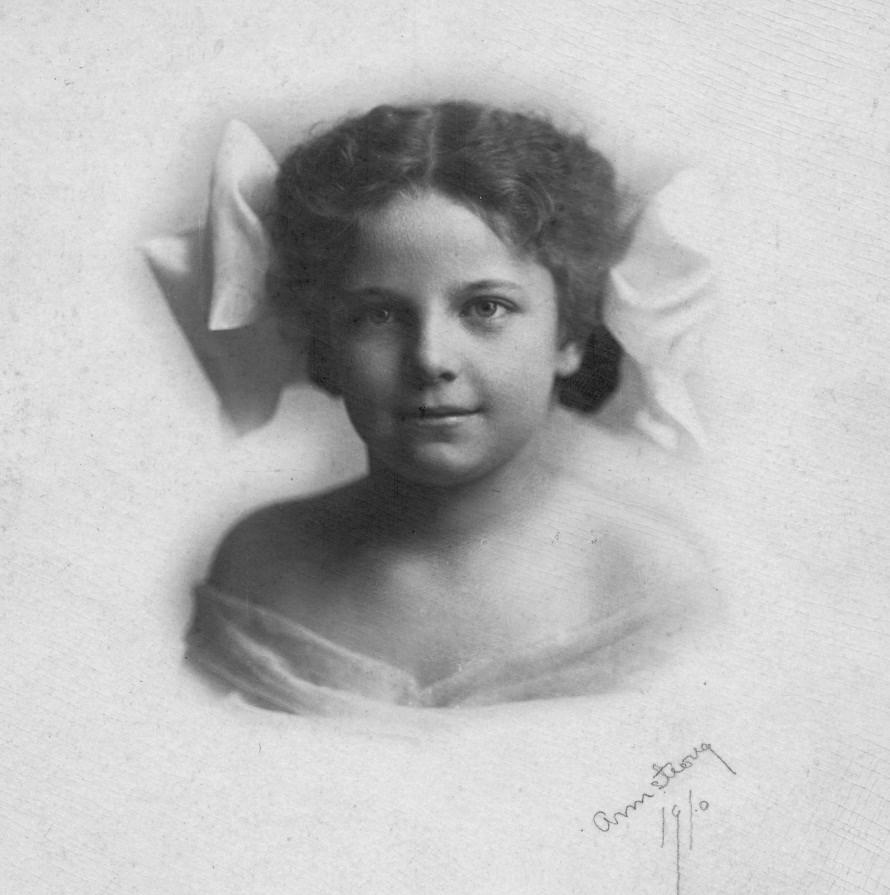
National Archives and Records Administration, 1972.); FHL microfilm 1,240,119 (accessed April 6, 2018).
6 Cooper family tree. U.S. City Directories, 1822-1995. 1905 and 1906. www.ancestry.com/family-tree/ person/tree/114619473/person/ 430131056286/facts (accessed August 24, 2017). “New Incorporations.” Denver Post, May 23, 1906, page 12.
7 “Cooper, Helen Sturtevant.” Birth record. Colorado Department of Personnel & Administration. www.colorado.gov/pacific/archives/ archives-search (accessed August 24, 2017).
8 “H.S. Instructor Dies Suddenly.” The Spokesman-Review, February 2, 1910, page 4. “James Cooper.” Certificate of
Death, # 110 7763. State of Washington, Department of Health, Death Index, 1907-1960; 1965-2014, Washington State Archives, http:// www.digita.archives.wa.gov (accessed June 25, 2018).
9 Karen Johnson. (August 10, 2017.) Email correspondence with Sister Linda Riggers, Holy Names Academy; and photographs of Holy Names Academy registry books in various years.
10 “William D. Stineman” obituary. The Seattle Daily Times, October 1, 1942, page 28.
11 “Helen C. Swift Appointed to Relief Post.” Seattle Post-Intelligencer, August 21, 1935, page 2.
12 Sigma Kappa Sorority membership certificate. Olympia Tumwater Foundation: Helen Shank Collection, 2016.8.
13 Diploma, Bachelor of Education degree, University of Washington to Helen Sturtevant Cooper. Olympia Tumwater Foundation: Helen Shank Collection, 2016.8.
14 Five-year normal diploma, University of Washington to Helen Sturtevant Cooper. Olympia Tumwater Foundation: Helen Shank Collection, 2016.8.
16 R. L. Polk & Co., Thurston and Mason Counties Directory, 1911-1924, Office of the Secretary of State, Washington State Archives, Digital Archives, page 48 (accessed September 6, 2017).
17 Polk’s Bremerton city and Kitsap County (Washington) directory. Seattle: R. L. Polk & Co., 1929-1938. Washington State Library Directory Room.
18 “Our Wedding Day” booklet chronicles the wedding of Helen and Swift, and includes a marriage certificate dated June 11, 1924. Olympia Tumwater Foundation: Helen Shank Collection, 2016.8.
19 “E. A. Swift, Former City Official, Dies.” The Seattle Daily Times, October 4, 1952, page 3.
20 “ ‘Speed’ Swift, Of City Law Office, Is Bridegroom.” The Seattle Daily Times, August 6, 1934, page 3.
21 “Cooper-Swift Marriage, Seattle, Brilliant Event.” Clipping from unidentified newspaper, June 11, 1924. Olympia Tumwater Foundation: Helen Shank Collection, 2016.8.
22 Life diploma, University of Washington to Helen Cooper Swift. Olympia Tumwater Foundation: Helen Shank Collection, 2016.8.
15 “High School Faculty Consists of Principal and 22 Teachers.” Olympia Daily Recorder, August 31, 1922, page 5.
23 “Grand Championship of Fifty High Schools of State Represented at Test Won by Martha Siler of Raymond.” The Seattle Daily Times, May 9, 1926, page 5.
24 University of Washington. University Directory. Seattle: University of Washington, 1923-1930.
25 “Mrs. E. A. Swift, Jr.” The Seattle Daily Times, July 19, 1928.
26 “Receives Appointment.” Seattle PostIntelligencer, October 31, 1929.
27 “Poppy Funds Aid Veterans And Helpless Dependants [sic].” The Seattle Daily Times, May 28, 1930, page 10.
28 The Forty & Eight was formed in 1920 as an offshoot of the American Legion, and by the next year was headquartered in Seattle. In 1922, the Forty & Eight established a Children’s Welfare project, with a small dues assessment dedicated to the care of orphans. “History Highlights of the Forty & Eight.” www.fortyandeight. org/history-of-the408/ (accessed July 23, 2017).
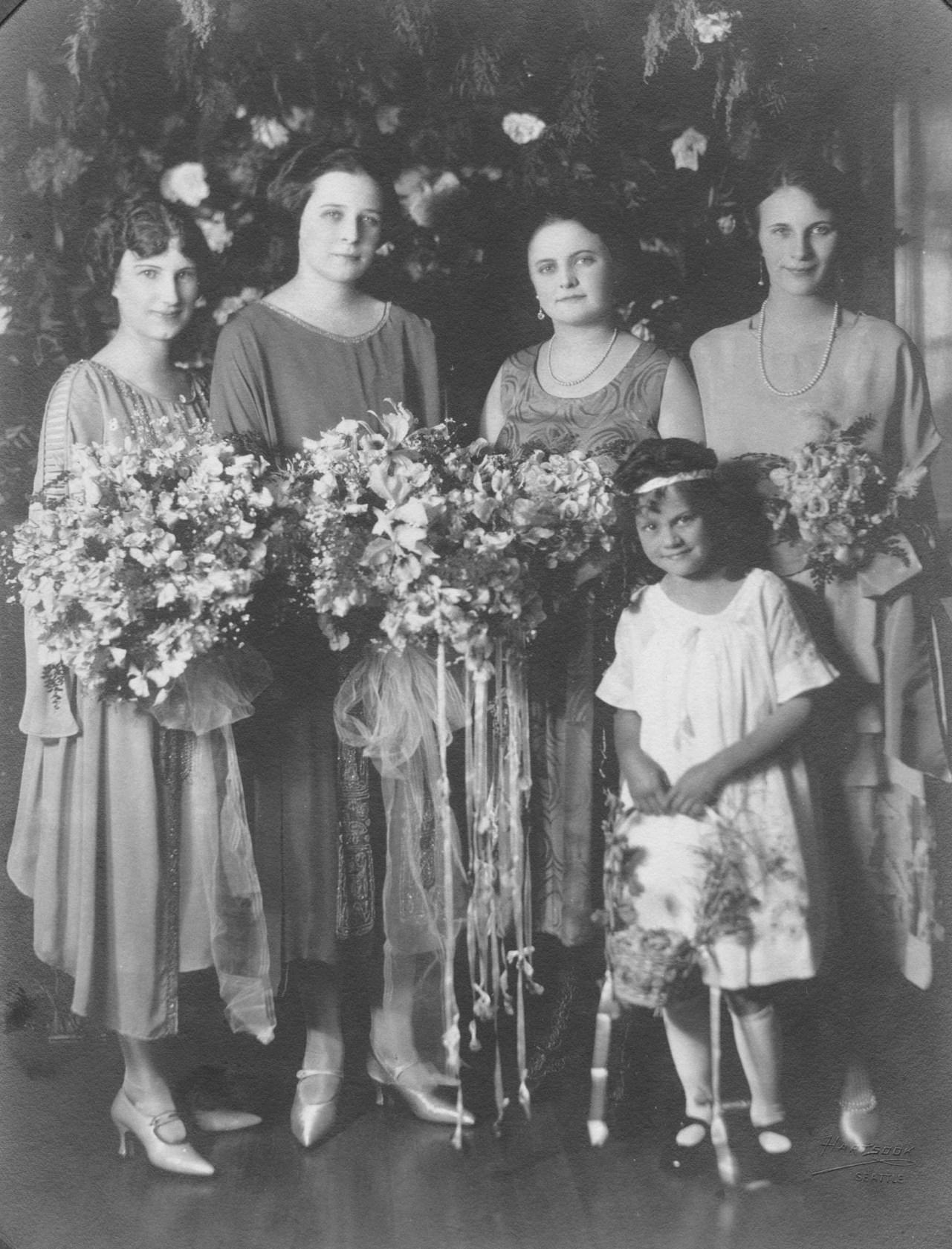
29 Lynn C. Worthington in “Washington Death Certificates, 1907-1960” database, FamilySearch, https://familysearch.org (accessed July 28, 2017).
30 “Legion Welfare Finds Home For Two War Wards.” The Seattle Daily Times, January 30, 1934, page 7.
31 “Injured Auxiliary Leaders Recovering.” The Seattle Daily Times, September 20, 1932, page 4.
32 “Christensen Named in Damage Suit.” The Daily Olympian, December 1, 1932, page 1.
33 Various marriage and death records at Washington State Archives. www.sos.wa.gov.
34 Karen Johnson. (March, 2018.) Email correspondence with Philip R. Meade.
35 “Mrs. Hansen, 84, Triumphs; Treks 4,000 Miles by Auto.” The Seattle Daily Times, April 12, 1935, page 5.
36 Alice Watts, “Twas A Gala Birthday Party Indeed.” The Sunday Olympian, November 30, 1980, page B1.
37 “Mrs. Helen Swift Will Head Child Welfare.” Bellingham Herald, August 20, 1935, page 1.
38 Invitation. Although no year is noted on the invitation, the weekday and date are mentioned; a perpetual calendar shows that this particular date and weekday coincided with the Roosevelt administration only in 1938. The Olympia Tumwater Foundation: Helen Shank Collection, 2016.8.
39 Karen Johnson. (June 14, 2017.) Phone interview with Randy Finley. Randy Finley and his sisters Pat and Sparkle viewed Helen as a “second mother.” Randy shared many stories about Helen.
Helen’s photo appeared in a wedding announcement in an unidentified Seattle newspaper clipping. The caption read: “The marriage of Miss Helen Cooper, daughter of Mr. and Mrs. W. D. Stineman, of Bremerton, to Mr. Edward A. Swift, was celebrated on the evening of June 11 [1924], at the Sigma Kappa Sorority House.”
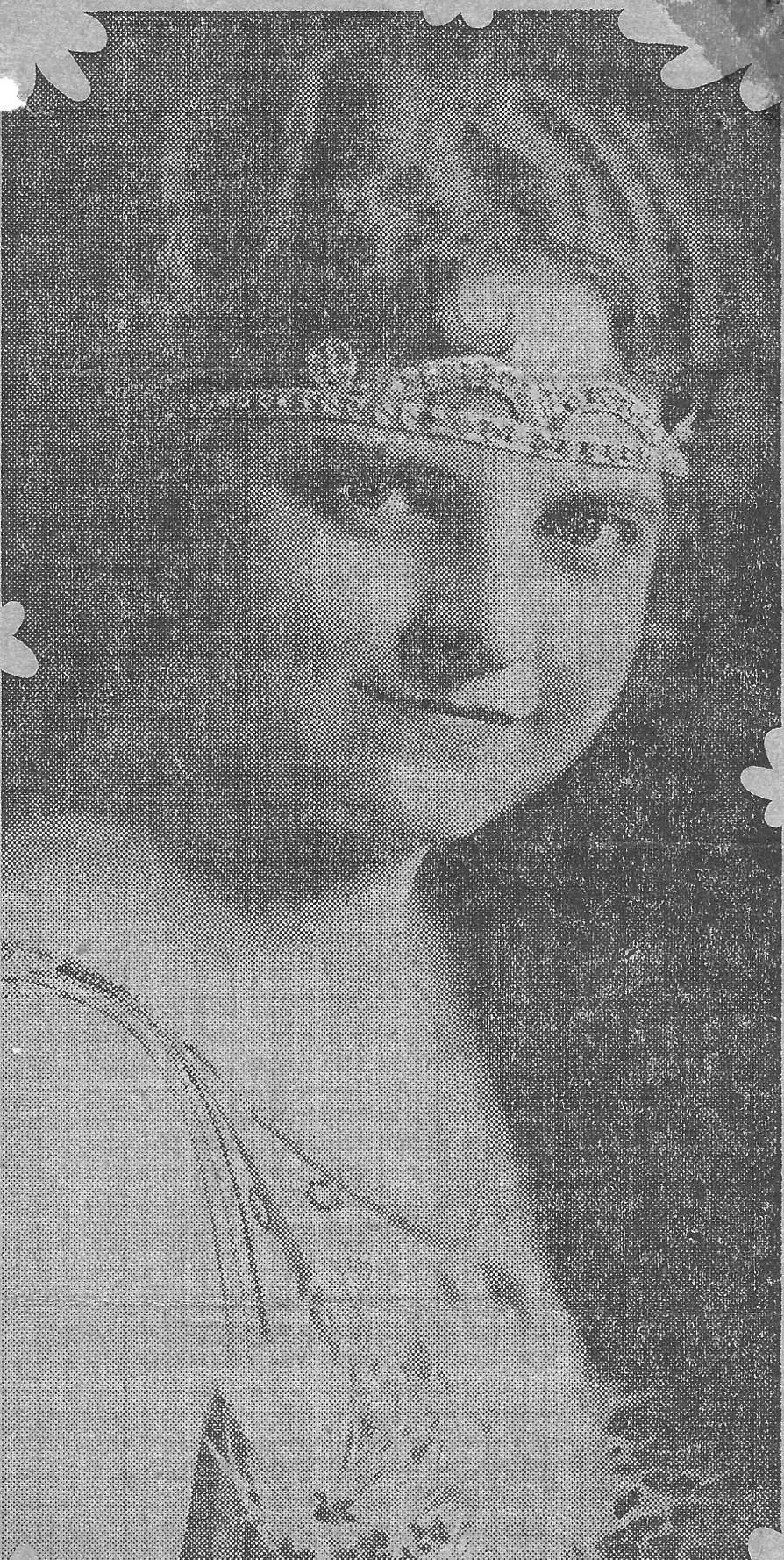
40 “State Children’s Director Resigns.” The Bellingham Herald, March 28, 1940, page 17.
41 Karen Johnson. (March, 2018.) Email correspondence with Philip R. Meade.
42 “Supervisor Quits Post.” The Tacoma Ledger, March 29, 1940.
43 Mason County Deed Book 136D, page 348. Washington State Archives, Southwest Branch.
44 “Eight former residents. . .” The Seattle Daily Times, August 14, 1943, page 6.
45 Karen Johnson. (March, 2018.) Email correspondence with Philip R. Meade.
46 The ranch in Mason County was spelled Trail’s End, with an apostrophe. The ranch in Thurston County dispensed with the apostrophe.
47 Trail’s End Ranch brochure, no date. The Olympia Tumwater Foundation: Helen Shank Collection, 2016.8.
48 Helen’s will stated that she had no adopted children. Washington State Archives: Probate case 87-4-00327-7, Estate of Helen C. Shank. Superior Court, Thurston County, Washington.
49 “Charles A. White” obituary. The Olympian, January 5, 2004 (accessed August 7, 2017).
50 Maxine Briggs, “Youth Council Is Organized in Mason County.” The Morning Olympian, June 24, 1943, page 2. “Washington State Defense Council records, 1942-1944.” University of Washington Libraries, Special Collections, Collection Number 1013.
51 “William D. Stineman” obituary. The Seattle Daily Times, October 1, 1942, page 28.
52 “Mrs. Mirett Hansen, Colorful Pueblo Resident, Passes Away.” Clipping from unidentified newspaper, October 20, 1943.
53 “Jack O. Shank, Ranch Owner, Forester, Dies.” The Seattle Daily Times, February 27, 1950, page 13.
54 “Washington Death Certificates, 1907-1960,” database, FamilySearch (https://familysearch.org/ark:/ 61903/1:1:N3Y5-TWT), Jack O Shank, 26 Feb 1950; citing Bremerton, Kitsap, Washington, reference 2854, Bureau of Vital Statistics, Olympia; FHL microfilm 2,032,906 (accessed April 4, 2018).
55 Karen Johnson. (March 2018.) Email correspondence with Philip R. Meade.
56 “Appointment Made.” The Bellingham Herald, December 3, 1950, page 24; Helen Swift Shank, State School for Girls, Oaths of Office, 1854-2015, Office of the Secretary of State, Washington State Archives, Digital Archives, http://digitalarchives.wa.gov (accessed August 9, 2017).
57 “Maple Lane.” Washington State Department of Social and Health Services, www.dshs.wa.gov (accessed July 28, 2017).
58 Werdna Finley, “Survey of Creative Dramatics in Correctional Institutions.” Geraldine Siks and Hazel Dunnington, editors, Children’s theatre and creative dramatics. Seattle: University of Washington Press, 1961, pages 168 ff. archive.org/stream/ childresntheatre00siks_djvu.txt (accessed August 9, 2017).
59 McMurry, “Trail’s End.” The Washington Horse, December 1967, pages 1198-1199.
60 “Appointment Made.”
61 “Olympia Venture Club Adopts Grand Mound Service Project.” The Daily Olympian, April 15, 1951, page 12.
62 “Escapees From Grand Mound School Sought.” The Seattle Daily Times, December 27, 1950, page 9.
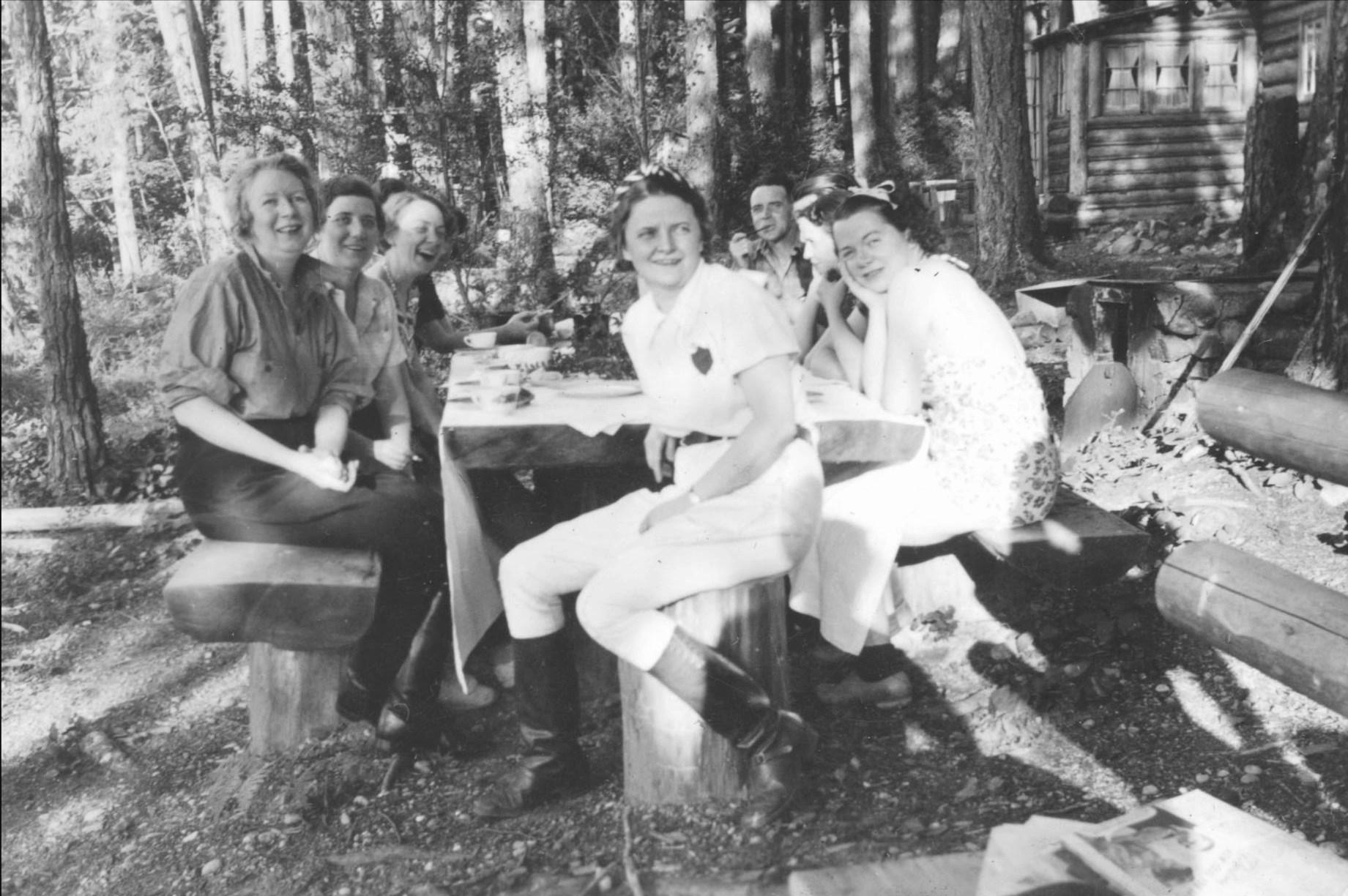
63 F. H. Butterfield, State of California Youth Authority, to Mrs. Helen Shanks [sic], June 24, 1953. Olympia Tumwater Foundation: Helen Shank Collection, 2016.8.
64 Werdna Finley, “Survey of Creative Dramatics in Correctional Institutions.”
65 “Helen Shank To Speak For Mental Health Association.” The Daily Olympian, March 21, 1954, page 17.
66 “Girls School in Uproar Following Attack.” The Oregonian, September 20, 1957, page 22.
67 “Rebellious Girls Injure 2 at School.” The Seattle Daily Times, September 23, 1958, page 1.
68 Samuel R. Sperry, “Maple Lane’s Success Told.” The Daily Chronicle, Centralia, WA, July 27, 1967, page 1.
69 “Pay Raises Given Institution Heads.” The Seattle Daily Times, July 27, 1959, page 2.
70 Marjorie Jones, “Group Home Planned for Girls Released From Maple Lane School.” The Seattle Daily Times, August 18, 1959, page 47.
71 “Protests On Home For Girls Rejected.” The Seattle Daily Times, February 11, 1960, page 10.
72 John J. Reddin, “Home for HardLuck Girls to Open Soon.” The Seattle Sunday Times, September 15, 1963, page 51.
73 “Commissioner’s Notice of Hearing.” The Daily Olympian, July 2, 1953, page 2.
74 Karen Johnson. (March 2018.) Email correspondence with Philip R. Meade.
75 Certificate of membership, NASW. Olympia Tumwater Foundation: Helen Shank Collection, 2016.8.
76 “Blanche E. Wood.” Department of Health Death Index, 1907-1960; 1965 -2014, Washington State Archives, Digital Archives, http://www. digitalarchives.wa.gov (accessed October 25, 2017).
77 Karen Johnson. (August 1, 2017.) Phone interview with Randy Finley.
78 Stanton H. Patty, “Woman Is Appointed To State Parole Board; Mrs. Helen C. Shank Appointed.” The Seattle Daily Times, March 14, 1960, page 1.
79 Helen C. Shank, Oaths of Office, 1854-2015, Office of the Secretary of State, Washington State Archives, Digital Archives, http://digital archives.wa.gov (accessed July 23, 2017).
80 In 1986, the board’s name was changed to the Indeterminate Sentence Review Board (ISRB). The ISRB’s current mission statement is to make “informed decisions essential to public safety regarding the confinement or release of individuals under its jurisdiction.” Doc.wa.gov/corrections/isrb/
default.htm (accessed July 23, 2017); Helen C. Shank, Prison Terms & Parole Board, Oaths of Office, 18542015, Office of the Secretary of State, Washington State Archives, Digital Archives, http://digitalarchives.wa.gov (accessed August 9, 2017).
81 Stanton H. Patty, “Parole Board Appointments Hit.” The Seattle Daily Times, November 27, 1961, page 8.
82 “Appointee Confirmed.” The Seattle Daily Times, March 10, 1961, page 9.
83 Dick Clever, Julie Emery and Duff Wilson, “Man of hidden rage faces murder charge again.” The Seattle Daily Times, July 23, 1982, page 4.
84 “Slayer of Carhop In 1948 Will Be Paroled August 7.” The Seattle Daily Times, January 3, 1962, page 1.
85 Julie Emery, “1962 paroling of Gasser defended by former official.” The Seattle Daily Times, July 25, 1982, page 23.
86 “Parole Board Views Regarding Gasser’s Release.” The Seattle Daily Times, January 23, 1962.
87 The John Gasser case appeared under the title “The Accountant” in Ann Rule’s true crime book Last Dance, Last Chance, published by Simon and Schuster, 2003.
89 Stanton H. Patty, “Sweeping Changes in States Parole System Recommended.” The Seattle Times, May 16, 1963, page 28.
90 “Mrs. Shank Elected.” The Tacoma News, November 2, 1963.
91 Press Release, Special to the Bellingham Herald. August 12, 1963. Olympia Tumwater Foundation: Helen Shank Collection, 2016.8.
92 “Trails End Ranch” brochure, no date. Olympia Tumwater Foundation: Helen Shank Collection, 2016.8.
93 Robert Finley and his wife Werdna were first introduced to each other by Helen. (August 1, 2017.) Phone interview with Randy Finley.
94 Karen Johnson. (March, 2018.) Email correspondence with Philip R. Meade.
95 “Trails End Ranch Camp for Boys and Girls,” 1966 brochure. Olympia Tumwater Foundation: Helen Shank Collection, 2016.8.
96 “They Learn Best By Doing.” The Daily Olympian, May 14, 1964, page 1.
97 “Suds to Soda Pop.” The Daily Olympian, August 18, 1963, page 1.
88 “Mrs. Shank Resigns From Parole Board.” The Seattle Daily Times, September 14, 1962, page 4.
98 American Camping Association “Camping Appreciation Award.” Undated. Olympia Tumwater Foundation: Helen Shank Collection, 2016.8.
99 Trails End Stables, Inc. history card. Washington Secretary of State, State Archives, Corporations, Articles of Incorporation, Box #239. List of Officers and Directors, Articles of Incorporation, Box #239.
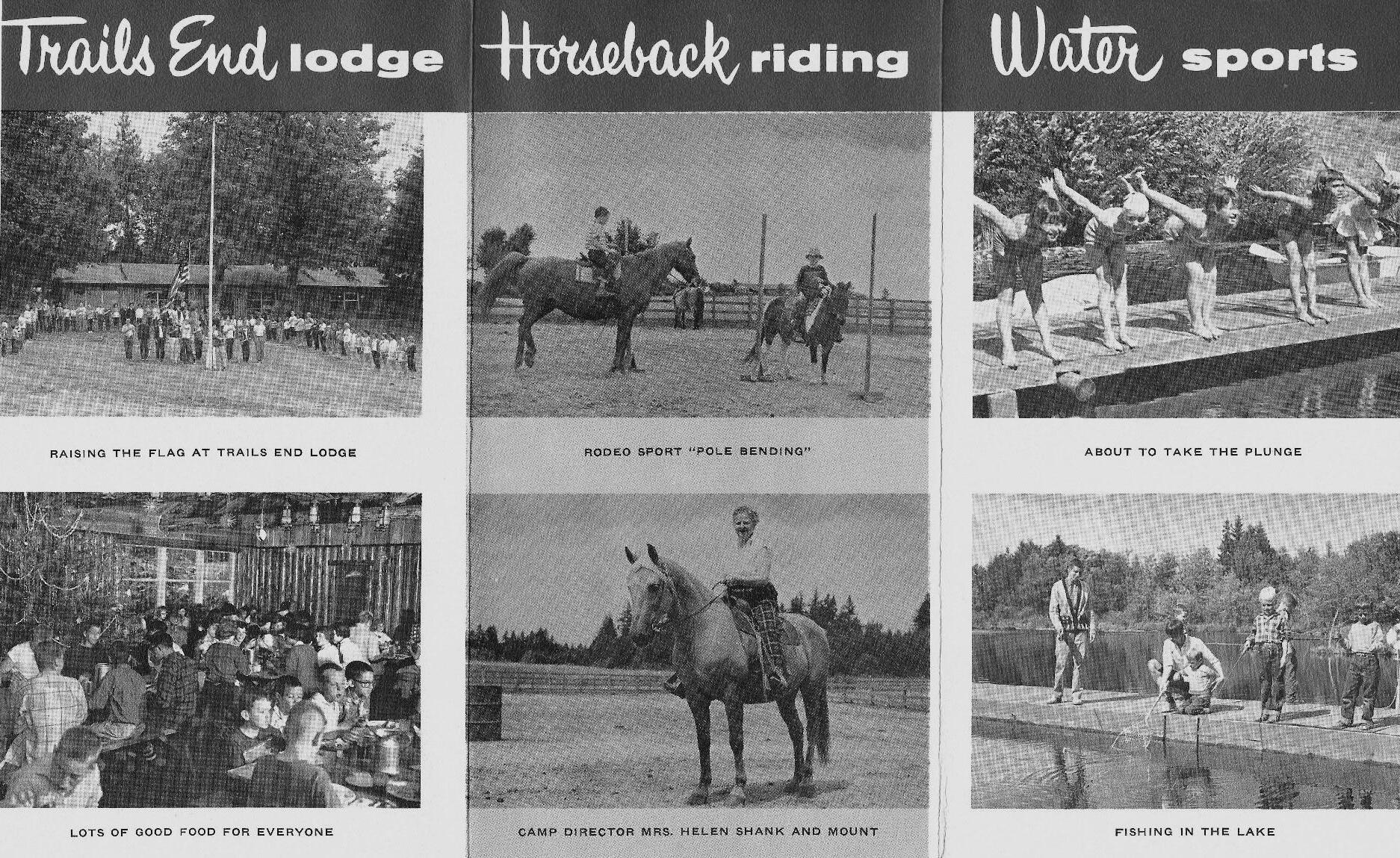
100 “Cattleman Of Year Ceremony Is Set.” The Daily Olympian, June 15, 1962, page 6.
101 “Trails End’s story started before Washington admitted as state.” The Lariat, February 1979, page 36 ff.
102 Alice Watts, “Happy Travelers Hit The Highway For The Tall Timbers.”
The Daily Olympian, February 8, 1967, page 1.
103 “Business Bits.” The Sunday Olympian, October 27, 1968.
104 “College Foundation Receives Largest Single Donation.” Liaison for Friends of South Puget Sound Community College, Winter 2005.
105 Alice Watts, “A Woman With an Eye and Heart for History Has Plans for Home of Son of George Washington Bush.” The Daily Olympian, February 14, 1969, page 2.
106 “Old Bush Home Tumbles, Now Another Kind of Memorial Sought.” The Daily Olympian, March 5, 1970.
107 Alice Watts, “Helen Shank Trail Days Event To Feature Horse Show, Barbecue.” The Daily Olympian, August 16, 1974, page C1.
108 Alice Watts, “Finley throws a mean pot.” Tacoma News Tribune, March 4, 1976, page D-11. “Judging The Fun Of A Little Pottery.” The Daily Olympian, March 14, 1976.
109 “Trails End Changing Hands.” The Daily Olympian, March 15, 1977, page 1.
110 Advertisement, The Daily Olympian, December 12, 1979.
111 “Trails End’s story started before Washington admitted as state.” “Wild Cow Milking Rodeo Event.” The Daily Olympian, April 29, 1981, page B1.
112 “County Bids For Olympic Event.” The Daily Olympian, April 1, 1981, page B2.
113 Dick Clever et al, page 4.
114 “Parole board named in suit.” The Olympian, July 17, 1984.
115 Julie Emery, page 23.
116 “John Gasser.” U.S. Social Security Administration, Washington State Death Index, 1937-2014 Washington State Archives, Digital Archives,
http://digitalarchives.wa.gov (accessed July 23, 2017).
117 Alice Watts, “Twas A Gala Birthday Party Indeed.” The Sunday Olympian, November 30, 1980, page B1.
118 “Special Guests” guest book. Olympia Tumwater Foundation: Helen Shank Collection, 2016.8.
119 Birthday congratulations card from Rosalynn and Jimmy Carter to Helen Shank, postmarked November 24, 1980. Olympia Tumwater Foundation: Helen Shank Collection, 2016.8.
120 Karen Johnson. (August 1, 2017.)
Phone interview with Randy Finley.
121 Interim Report of Elie Halpern, Personal Representative of Estate of Helen C. Shank, dated October 28, 2004. Washington State Archives: Probate case 87-4-00327-7, Estate of Helen C. Shank. Superior Court, Thurston County, Washington. “Rosario Resort goes on the block.” The Bellingham Herald, September 9, 1984, page 8.
122 Karen Johnson. (August 1, 2017.)
Phone interview with Randy Finley.
123 Get-well card from Agnes Haaga to Helen Shank, April 4, 1985. Olympia Tumwater Foundation: Helen Shank Collection, 2016.8.
124 “Helen C. Shank.” Certificate of Death, # 7 29567. State of Washington, Department of Health. Bob Gunter (listed as Helen’s grandson, but actually a family friend and not a
blood relation) acted as the informant for the death certificate, and misstated some information. The certificate lists Robert S. Cooper as Helen’s father, whereas his correct name was James Fennimore Cooper. Blanche Anderson is listed as Helen’s mother, whereas her correct maiden name was Sturtevant.
125 “Helen Shank, First Child Welfare Supervisor, Dies.” Seattle PostIntelligencer, August 17, 1987.
126 “Helen Shank: A Lifetime of Helping Children.” The Seattle Times, August 22, 1987.
127 Interim Report of Elie Halpern, Personal Representative of Estate of Helen C. Shank, dated October 28, 2004. Probate case 87-4-00327-7, Estate of Helen C. Shank. Superior Court, Thurston County, Washington. Washington State Archives.
128 Kenneth J. Minnaert and Holly Mason, South Puget Sound Community College, letter to the Honorable Christine A. Pomeroy, Thurston County Superior Court, dated October 27, 2004. Washington State Archives: Probate case 87-4-00327-7, Estate of Helen C. Shank. Superior Court, Thurston County, Washington.
129 “College Foundation Receives Largest Single Donation.” Liaison for Friends of South Puget Sound Community College, Winter 2005.
130 Viola A. Mitchell and Ida B. Crawford, Camp Counseling. Philadelphia: W. B. Saunders, 1950, page 11.
Karen L. Johnson has worked in the museum field since 2001. Her interests in early transportation and the pioneer era have led to organizing two stagecoach runs between Olympia and Longview, writing many articles on local and regional history, and coauthoring with Dennis Larsen two books about a Washington pioneer. She currently serves as the curator at the Schmidt House, owned by the Olympia Tumwater Foundation.
The author thanks the following: Kristie Tedford, who donated the box of Helen’s ephemera found in one of the old barns; Byron Schrock and Kari Johnson, Schmidt House volunteers who initially processed the ephemera; Sister Linda Riggers and her colleagues of Holy Names Academy, who went to great lengths to find Helen’s school records; Jewell Dunn, for her assistance with genealogy research; Erin Quinn Valcho, for her thoughtful editing suggestions; Randy Finley, who worked at Trails End, was a family friend, and viewed Helen as a second mother; and Philip R. Meade, who was a great friend of Helen’s and shared many memories of life with her.
On a cold and sunny winter morning I found myself driving along Delphi Road in Olympia, near McLane Creek. Only minutes from the bustling Westside, the area is like many parts of the county: part rural, but near convenience; coated in moss with a reddish-brown blanket of decaying leaves and lichen-covered trees. There are open prairies and thickets of trees, both beautiful, especially with the sun shining through patchy fog, showing off the wet earth that makes green in the Northwest vibrant even during the dreary months. There are older homes next to newer ones, some painted colorfully, and others hidden behind trees that protect them from the road. Nearby are the McLane Grange and Elementary School as well as some farms and ranches. Although the area isn’t really off the beaten path, it radiates an air of calm and seems further away from the city than it is.
There are numerous aging, old, and historic homes throughout Olympia and the county. Many have been lived in by prominent pioneers and politicians, or otherwise significant leaders of South Puget Sound. A particular house located along Delphi Road SW is unique in that two noteworthy parties have claimed ownership of the
beautiful property and buildings that reside on it: a local monastery and a famous (and famously controversial) musician and actress, Courtney Love.1
The original builder and owner of the house was a woman named Leona Meeker. Prior to 1930, Leona was married to Dan Phelps, who owned the property. In the early to mid-1930s, the land had a five-room house on it, which may have been what was considered the chicken coop in later years. In 1933, the Phelpses divorced and each got half ownership in the land. Leona later obtained sole ownership of the land by paying off the mortgage. In 1938, Leona married Ernest Meeker. She was a successful woman in her own right, working as a beautician in Olympia and eventually owning a beauty parlor. Together with her second husband, she made significant improvements to her property in 1940 by building a modest and comfortable home. She sold the estate to the Order of Saint Benedict in the summer of 1952.2
The Benedictine sisters first came to Washington in 1892 from Saint Benedict Monastery in St. Joseph, Minnesota, to staff Holy Rosary School in Tacoma. For decades the sisters lived in Tacoma, staffing Visitation School (which opened in 1925), then All Saints’ School (1954), and St. Ann’s School (1956). After World War II, as over 1200 Benedictine Sisters connected with Saint Benedict Monastery, some missions began the process of becoming independent monasteries.3 In order to establish an independent monastery, property was required and Archbishop Connolly of the Archdiocese of Seattle insisted that the Benedictines purchase land outside the Seattle-Tacoma area, where there were few religious orders.
In 1952, the Delphi house came up for sale. The site was purchased by the Order of Saint Benedict in July 1952. In March 1953, the St. Placid Priory was incorporated as a non-profit institution in Olympia, and in September of that year the Order of Saint Benedict conveyed the property to the Priory.4 Although the number of founding community members at 35 was small, an even smaller fraction of the sisters actually lived in their new house. Instead, it was used as a place to train and acclimate new members.

One of the principal goals of St. Placid
Priory was to establish a school to complement Saint Martin’s High School for boys.5 After years of effort, a girls’ school was opened in the fall of 1961 near the site of the current priory, off College Street and Martin Way
in Lacey. Saint Martin’s Abbey donated approximately 75 acres of mostly wetlands after the construction of Interstate 5 cut through Abbey property. St. Placid High School was in operation from 1961 to 1985, when it then became Priorywood Daycare Center and The Priory Spirituality Center. In 1992, the sisters moved into their new monastery complex, closing Priorywood Daycare and expanding The Priory Spirituality Center. The priory still stands today in a peaceful wooded area not far from Saint Martin’s University. The order is small, with about a dozen community members (with numerous women in formation to become sisters), but where they live and pray is much different than when they occupied the Delphi Road property.
The current 1.5 story structure on Delphi Road is a three-bedroom, twobath home, with a full basement. It comprises roughly 2,300 square feet constructed with a concrete foundation, cedar siding, and clay tile roofing. The floorplan is T-shaped, where each wing is one story and the middle is 1.5 stories with a center gable. White-painted brick columns hold up the center gable, and two thinner brick columns support the balcony and portico that grace the front façade. A single-stack exterior chimney stands on the south side of the house and according to Sister Laura Swan, current archivist for the Priory, the father of one of the founding members was a carpenter who installed a beautiful mantel on the main fireplace when the sisters moved in. From historical photographs, the house ap-
pears to have been always painted white with green shutters on the front.
The main structure was not big enough to house an entire monastery, so while the Priory officially had legal standing as a Benedictine priory and its own home, only a few established nuns lived at the Delphi Road property at any given point. The first prioress, Mother Placidia Haehn, and four other nuns dwelled in the main house. The rest of the members were on missions, living at the schools where they taught.
The finished basement, described as large and comfortable, served as the Chapter (meeting) room and was long enough to hold large banquets on holidays. The chapel was located on the main floor.

Top: The house as the sisters left it, 1962.

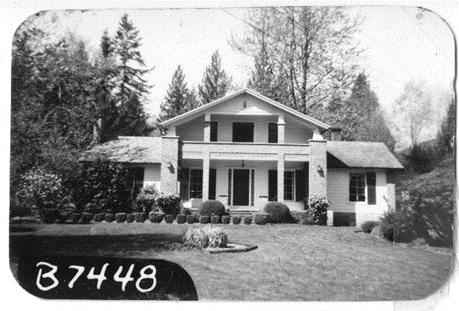
Bottom: “St. Mary’s” dorm, the converted chicken coop, under new ownership, 1962.
Both photos courtesy of the Thurston County Assessor’s Office.
Outbuildings were erected at the same time the house was built in 1940. According to Sister Laura Swan, one building was a chicken coop that the nuns converted into living quarters for women training to take their vows. The assessor’s records indicate that the building was a dormitory with a “long narrow hall.”6 This dorm was dubbed St. Mary’s. The other building was a detached garage. In 1978, well after St. Placid Priory moved away, a stable was built. Modern aerial imagery suggests an in-ground pool now exists on the site as well, but while the sisters occupied the land, just the dwellings and garage stood.
The Order owned the Delphi property only from 1952 until 1960, when it sold the property and moved its community to Lacey, near the site of the current priory.
Over the following three decades, the property was sold eight times. During the early 1970s, Saint Martin’s alumnus Robert Schmidt Jr. owned the home. Robbie is the son of former Olympia Brewing Company president, the late Bobby Schmidt. Robbie began working in the family business in 1959, during his summer vacations, and like all the Schmidt family members who worked in the brewery, he started at the bottom and hopped around departments learning a breadth of skills. In 1968 he became assistant brewmaster and “held several key positions” in Tumwater and St. Paul. In 1980 he became the Vice
Detailed records for the property do not extend beyond the early 1990s, creating gaps in the story. However, between 1960 and 1974 the house had five different owners, so unlike Tumwater’s historic Schmidt House built for Robbie’s great-grandfather, the Delphi Road property likely doesn’t contain a rich history of one of the most significant families in the area at the time.
In January 1995, musician (and later actress) Courtney Love Cobain purchased the home.8 By all accounts, Love had a whirlwind of a childhood, moving frequently and getting an education in numerous countries. She spent a great deal of her youth in Oregon, returning to Portland frequently when her music career started gaining traction in the 1980s. She formed an alternative rock band, called Hole, in 1989. The band quickly gained popularity in the alternative rock world and they played shows from Los Angeles to New York, often with well-known bands of the same genre, like Seattle’s Mudhoney and the Smashing Pumpkins.9 In 1992, Love married Nirvana front man and Aberdeen native Kurt Cobain. The early 1990s were the height of the Seattle grunge scene and the two were at the peak of their singing careers Nirvana’s hugely successful album Nevermind and Hole’s debut album were both released in 1991.
Love had clear and understandable
connections to the Northwest, living in Portland and having a husband from Washington, but at first it might seem strange that she purchased a home on the outskirts of Olympia. It makes more sense when considering her relationship with Cobain. It is beyond the scope of this article to delve into their oft-analyzed and tumultuous relationship, but appreciating Cobain’s link to Olympia gives insight into possible reasons why Love bought the property.
Nirvana usually gets lumped in with other Seattle-based grunge bands like Pearl Jam or Soundgarden, but Nirvana’s roots go back to Aberdeen where Cobain and bassist Krist Novoselic formed the group in 1987. Soon afterwards, the friends moved to Olympia where they frequented music venues in town and in Tacoma. Reportedly, this time in Cobain’s life is when he found his artistic self and came into his own as a musician.10 The group disbanded after Cobain’s death in April 1994, but during its seven-year lifespan Nirvana became one of the most influential alternative rock groups of all time. Therefore, it is no small matter that Cobain spent some time in Olympia. The arts and culture of the city helped nurture a life that was sadly cut short and still resonates with millions of people today.
Since Courtney Love never explicitly stated her rationale, it is impossible to know her reasoning behind buying the house on Delphi Road. Cobain played multiple gigs at The Evergreen State College and performed his first on-air broadcast on their radio station,
KAOS. He may have liked the area enough that after his passing Love wanted to be close to it, too. Or possibly in the months after her husband’s death she simply wanted to have a quiet place to mourn, although she states in her book Dirty Blonde that she didn’t take the time to grieve her loss for years afterwards.11 While Cobain lived in Olympia for only a few years before becoming famous, and the couple hopped around different hotels and houses in Seattle for most of their marriage, Olympia offered refuge from city life and privacy to someone prone to making headlines. Alternatively, owning a quiet place for her daughter, not even two years old at the time of Cobain’s death, could have been a factor.
According to a biography of Cobain (Heavier than Heaven by Charles Cross), on Memorial Day 1999, Cobain’s mother Wendy Cobain, Courtney Love, and daughter Frances Bean Cobain scattered some of his ashes into McLane Creek.12 The book incorrectly states that McLane Creek flowed behind the home of Cobain’s mother on Bordeaux Road in Littlerock.13 What is clear is that the Littlerock house could not have been where the ashes were scattered, since it is miles away from the creek. The house on Delphi Road and its 6.78 acres contain a large portion of Swift Creek, a tributary of McLane Creek. It is more likely that this is one of Cobain’s final resting places.14
Today the house is in disrepair. Caution tape is spread over the entrance
gate and garbage is strewn about the driveway. Graffiti is visible on the detached garage. It looks like a place that teenagers sneak into after dark, to do whatever teenagers do after dark. Love still owns the property, but it seems whatever drew her to it at one point is gone, as the house has clearly been neglected. Regardless, the Delphi estate no doubt has an interesting history, as all houses do. People are fascinated by old houses; often, people claim to not be interested in history but are simultaneously in awe of old homes and the people who lived in them. This one house has had nine different owners, with exceptionally different backgrounds, careers, stories, and personalities. I chose Live Through This, the name of Hole’s second album, as the title of this article because it is a reminder that the buildings we live in have stories to tell.15 Their walls continue to stand as the tenants come and go, living through spiritual awakenings and personal tragedies.
https://commons.wiki media.org/wiki/File:Courtney_Love_ (17890556711)jpg.

1 Although the general location and photos of the property are provided, the exact address of the home has been omitted from this article for the sake of the owner’s privacy.
2 Washington State Archives: Dan Phelps vs. Leona Phelps, Divorce Record 15215. Thurston County Deeds Book 266, page 284, Leona Meeker to Sisters of the Order of Saint Benedict.
3 Megan Ockerman. (January 12, 2018.) In-person conversation with Sister Laura Swan. Although monasteries are often associated with monks, the term “monastery” applies to both men’s and women’s communities. A “priory” is a small monastery but the Sisters of St. Placid Priory liked the alliteration and chose not to make the name change to monastery.
4 Articles of Incorporation, March 25, 1953, Olympia, WA. Washington State Digital Archives, https://www.digital archives.wa.gov/Record/View/ADD9E
7364CDF6022D9066888A30E27BA
(accessed January 7, 2018). Thurston County Deeds Book 277, page 221.
5 According to its website, Saint Martin’s originally contained “an abbreviated grade school, a high school, and a two year college. In the early 1940s, the grade school was dropped and the college became a four year institution.” By the mid-1970s the high school was also dropped. “History of Saint Martin’s.” Saint Martin’s Abbey, http://www.saintmartinsabbey.org/ OurMonastery/03.History.htm (accessed May 6, 2018).
6 Thurston County Assessor’s record, sheet 4.
7 “People.” On Tap (employee newsletter). Olympia, WA: Olympia Brewing Company, November 1980, page 11.
8 Assessor’s record. Love has since dropped Cobain from her name.
9 Richard Cromelin, "Pop Music Reviews: Pumpkins, Hole Unleash Frustrations." Los Angeles Times, December 19, 1991, http://articles.Latimes. com/1991-12-19/entertainment/ca712_1_pumpkins-album (accessed May 16, 2018).
/chasing-kurt-cobain-in-washingtonstate.html (accessed May 16, 2018).
11 Courtney Love, “Author’s Note.” Ava Stander, editor, Dirty Blonde: The Diaries of Courtney Love. New York: Faber and Faber, Inc., 2006, page ix.
12 Nicole Brodeur, “Sad Reminder of Kurt Cobain’s Legacy.” Seattle Times, January 5, 2006, https:// www.seattletimes.com/seattle-news/ sad-reminder-of-kurt-cobains-legacy/ (accessed January 7, 2018).
13 Brodeur. Love purchased this home in Littlerock for her former mother-inlaw in 1997 but stopped paying the mortgage in 2003. The home was auctioned in 2006.
14 Love has never publicly stated where Cobain’s ashes were spread. It is the author’s conjecture that his ashes may have been spread on her Delphi Road property.
15 Hole’s second album was written while Cobain was still alive, so the title does not refer to Courtney grieving her husband’s death.
10 Dave Seminara, “Chasing Kurt Cobain in Washington State.” New York Times, March 25, 2014, https:// www.nytimes.com/2014/03/30/travel
Megan Ockerman is a native Olympian with a love for the history of the area. She earned her Master of Arts in history from Washington State University in 2017 after having written the history of the Olympia Brewing Company for her master’s thesis. She currently lives in Portland.
This photo, taken in October 1966, is of Linda Kohout. Linda attended North Thurston High School, and in 1965, was chosen as that year’s Lakefair queen. As queen, she made many appearances around the region, including riding on the Capital Lakefair float entry in Seattle’s Seafair parade. The float had a Merchant of Venice motif.
In 1966, Linda entered the Miss Thurston County contest and was sponsored by the Lacey Area Chamber of Commerce. Linda won the crown over eight other contestants, and also won the title of Miss Congeniality. Her talent for the event was performing a Charleston dance number.
As Miss Thurston County, Linda received a $600 wardrobe, a $350 scholarship, and a set of luggage. She then spent the next eight months attending various pageants and functions throughout the area, including a visit to Fort Lewis where she was named “Miss 225th Mohawk” by the 225th Aviation Company. In early 1967, she handed out honorary degrees to 49 state senators and 99 state representatives as a way to publicize the state’s newly-created four-year college (although at that early date, The Evergreen State College did not have a campus or even a name).
Linda represented our county in the Miss Washington contest held in Vancouver in June 1967. During the com-
petition, she lived with a family in Vancouver. A Daily Olympian article reported, “Her days will be full [of] rehearsals, judges interviews, special events planned by the Vancouver Jaycees, teas, boat trips. She will present her bathing suit and evening gown competition Thursday night, and her talent Friday night. . . . Linda will be doing her Charleston routine for her talent contribution. . . . Everyone in Thurston County can be proud of our entry in the Miss Washington contest.”
Sadly, Linda did not win the Miss Washington crown.
In the fall of 1967, Linda enrolled at Washington State University. In 1969, she became a stewardess, serving on flights for Northwest Orient Airlines and Pan American Airlines. In 1970, she was among the first to crew on a commercial flight for the newlylaunched Boeing 747s. For a time, Linda lived in Washington, DC.
And the location of this photo? It was taken in front of the Operations Tower at Gray Army Airfield, Fort Lewis.
The photographer for the U.S. Army was Sp4 Manuel Oliver, Photographic Facility, Log Services Division, Fort Lewis. Photo courtesy of the Olympia Tumwater Foundation: OBC Business Photos, Box 41.
A lovely young woman, wearing a “Miss Thurston County” sash, stands in front of a checkered metal building. Who is she? What year was the photo taken? Finally, where was this photo taken? (Hint: it’s not in Thurston County.) Turn to the inside back cover for the answers.
